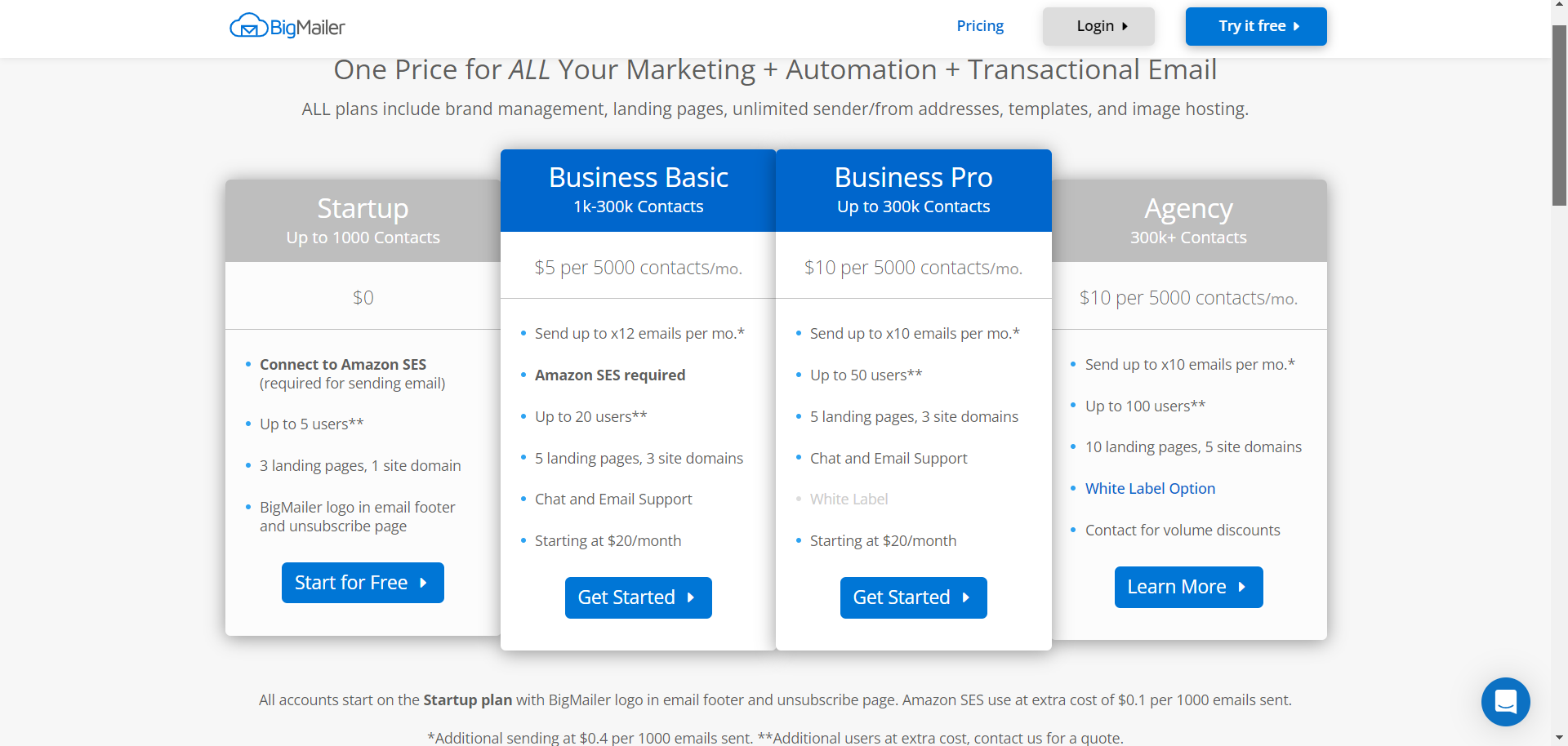10 Best beehiiv Alternatives in 2025
Published on January 1, 2025
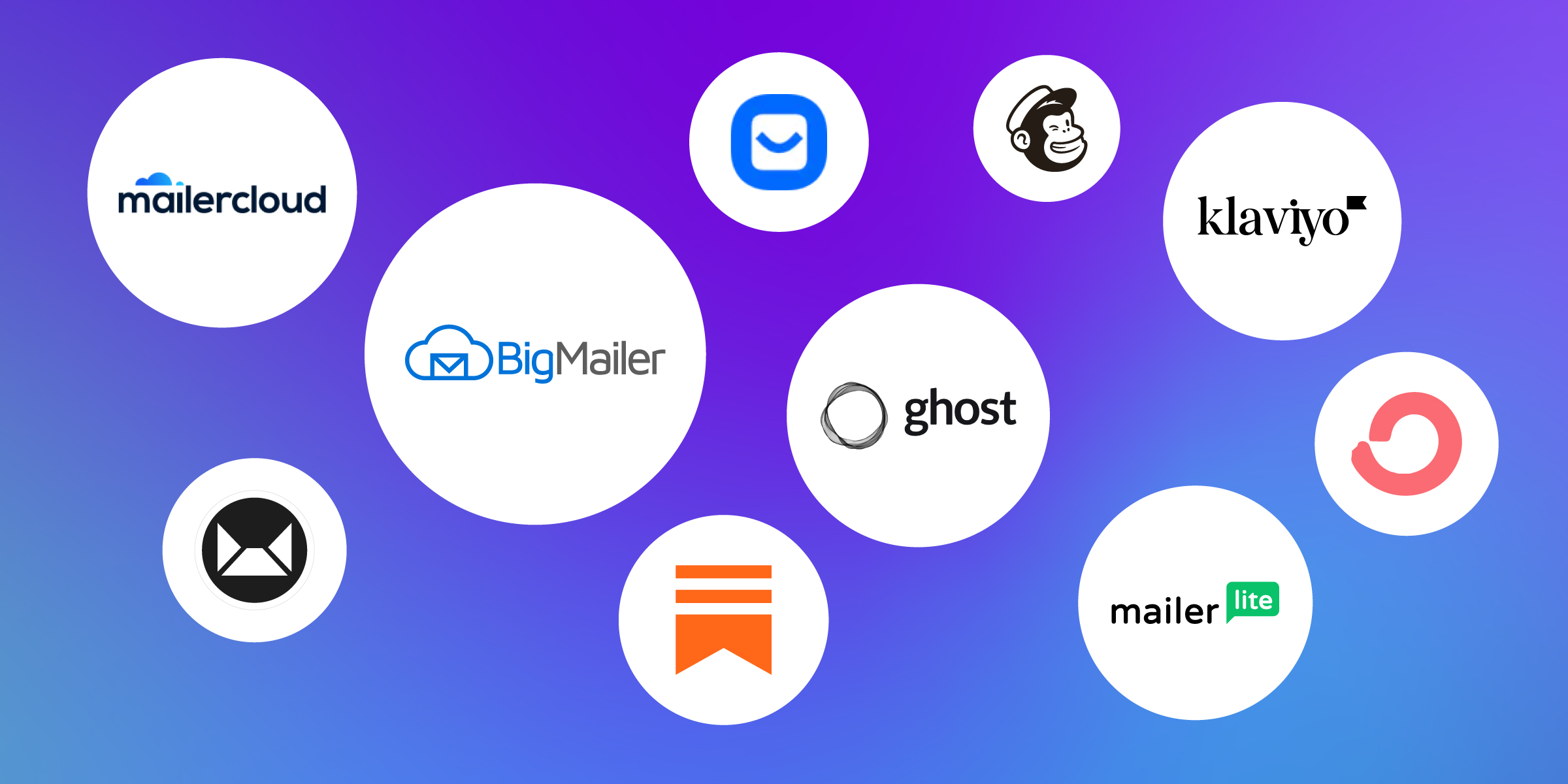
Beehiiv is a popular platform for content creators with plenty of growth features and competitive pricing.
But it’s not for everyone – and things have changed…
You might be considering an alternative because:
- The pricing increased in April 2024, and now grandfathered customers are facing the same increase (2-3X if you have 25,000+ subscribers).
- The free plan has numerous limitations and there’s a large leap in price for the more advanced features.
- beehiiv doesn’t natively support RSS-to-email for newsletters that need to distribute content automatically.
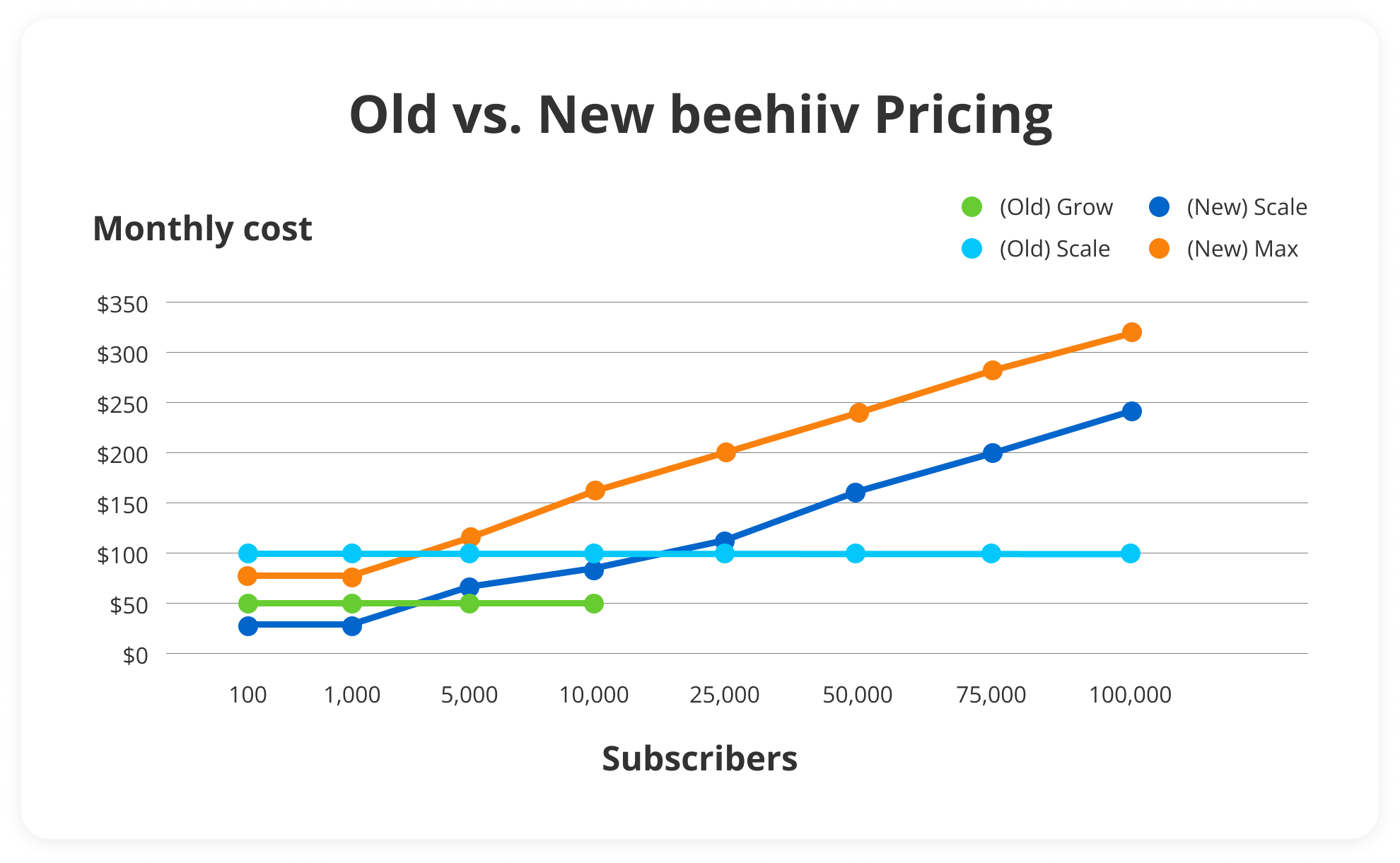
Those price hikes alone are a good reason to look for an alternative, especially if you have a large email list.
I’ve spent 20+ hours signing up for trials and reading through every customer review from the past year for these 10 beehiiv alternatives. I’ve categorized each alternative based on what I think it’s best at.
If you’re looking to save some money, I also created charts to show you how these alternatives’ pricing compares to beehiiv’s pricing.
Feel free to skip to the section you’re most interested in:
- Best Value for Large Email Lists: BigMailer
- Best for Publishing: Substack
- Best for Simplicity: Buttondown
- Best for E-commerce: Klaviyo
- Best for Campaign Analysis: Mailercloud
- Best All-In-One: Mailchimp
- Best for Bloggers: Ghost
- Best for Selling Digital Products: Kit
- Best for Budget Users: Sendy
- Best for Easy Design: MailerLite
- beehiiv Alternative Evaluation Checklist
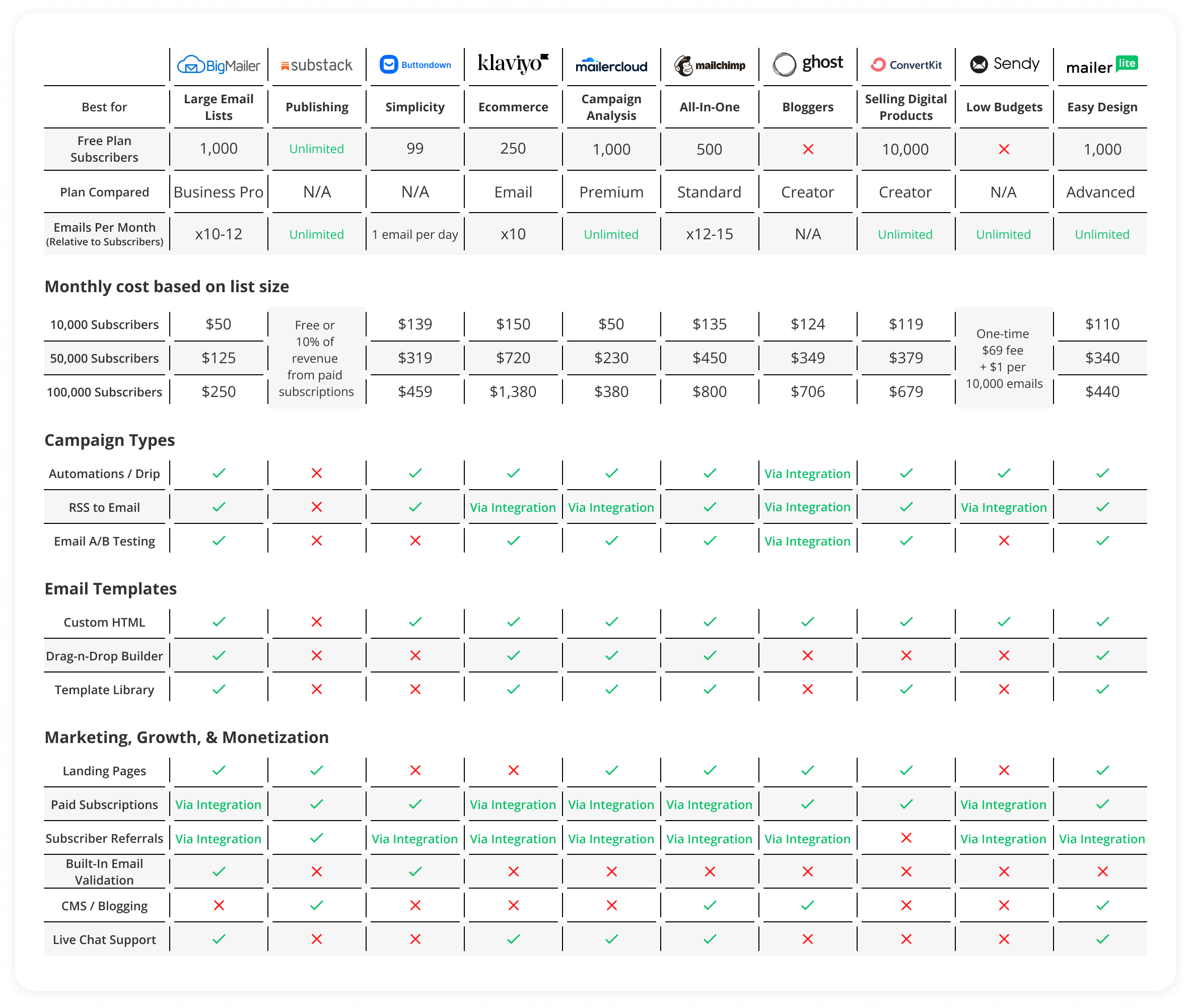
Best for Large Email Lists: BigMailer
If you’re a former beehiiv customer who outgrew their free plan OR you have a large email list, BigMailer is an alternative that could save you hundreds of dollars every month.
BigMailer is especially a good choice for marketing agencies, franchises, email consultants, or teams managing multiple brands that might need a white-label email marketing platform.
It has the most budget-friendly pricing out of all of these beehiiv alternatives while still having advanced features.
One of those features is BigMailer’s built-in brand and user-access management for you to easily manage multiple brands and team members from a single account. This allows you to keep all your clients, projects, team members, and email campaigns (marketing & transactional) in ONE place.
BigMailer’s customers rave about the top-notch customer service (available 7 days/week from 8 am – 8 pm EST). Just read through online reviews if you don’t believe me. Customers like that the support is very responsive and helpful, typically responding within minutes during business hours.
This is something you simply can’t get (or expect) from most major email marketing platforms.
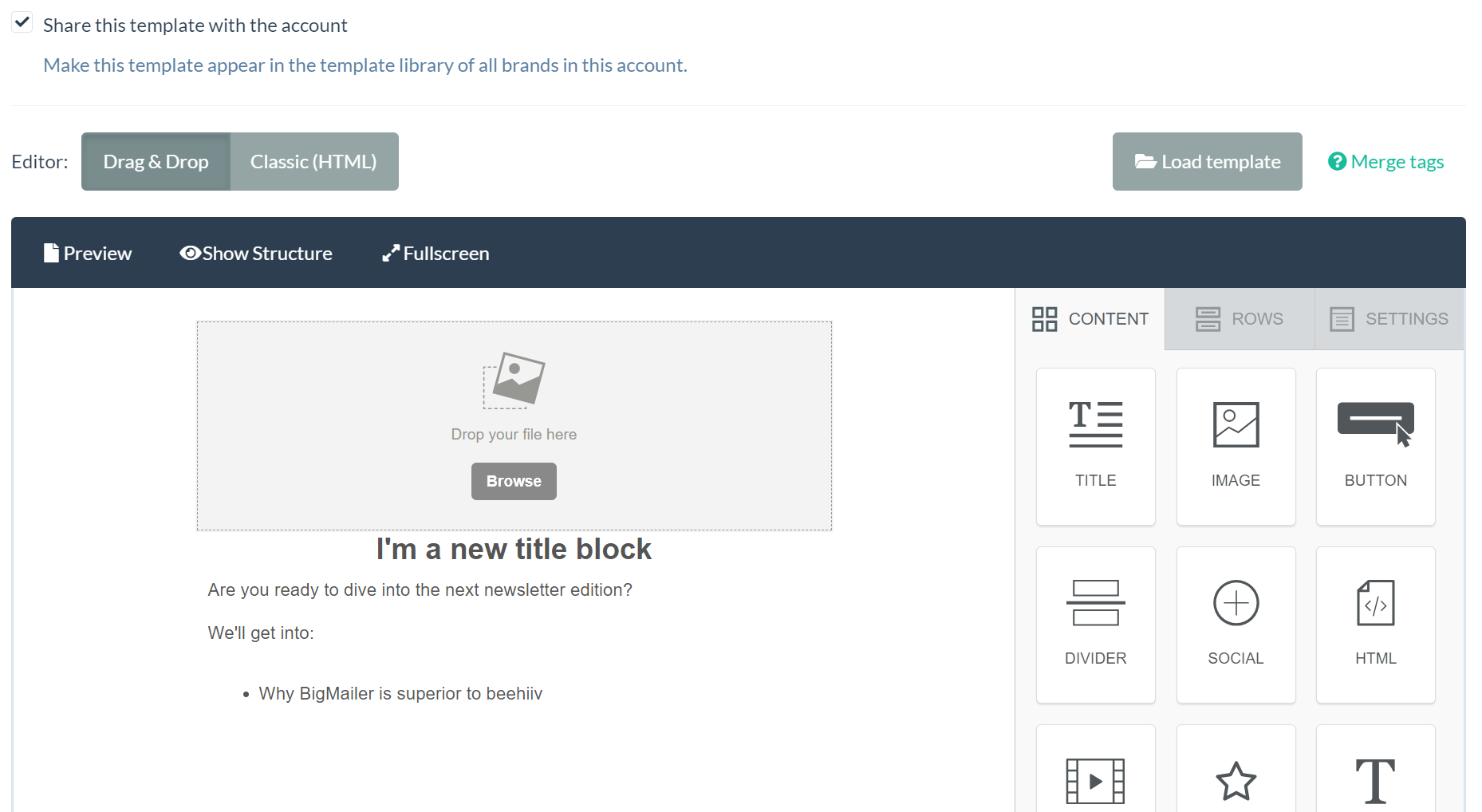
I also find BigMailer’s drag-and-drop email template builder quicker and more intuitive than most “budget” newsletter platforms on this list (many of them are clunky).
Here’s a video that gives you a quick demo:
Pros
- Affordable pricing for high volume sending (especially for over 100K+ list sizes)
- Great for marketing agencies or franchises that need to manage multiple accounts or brands
- White-label option
- The support is highly rated by customers
- Supports RSS-to-email automation
- Average of 99.7% delivery rate, thanks to built-in email validation
- Free plan available for up to 1,000 contacts
Cons
- Doesn’t offer an ad network like beehiiv
- Isn’t for publishing blog posts
- Not ideal for DTC or e-commerce companies (but neither is beehiiv) due to lack of direct integrations with Shopify and WooCommerce.
- Requires to verify sender domains with DNS records (like most providers), while beehiiv allows you to send from their domain.
Features
- Supports all email types – Newsletters, transactional, RSS-to-email, automations, and sequences.
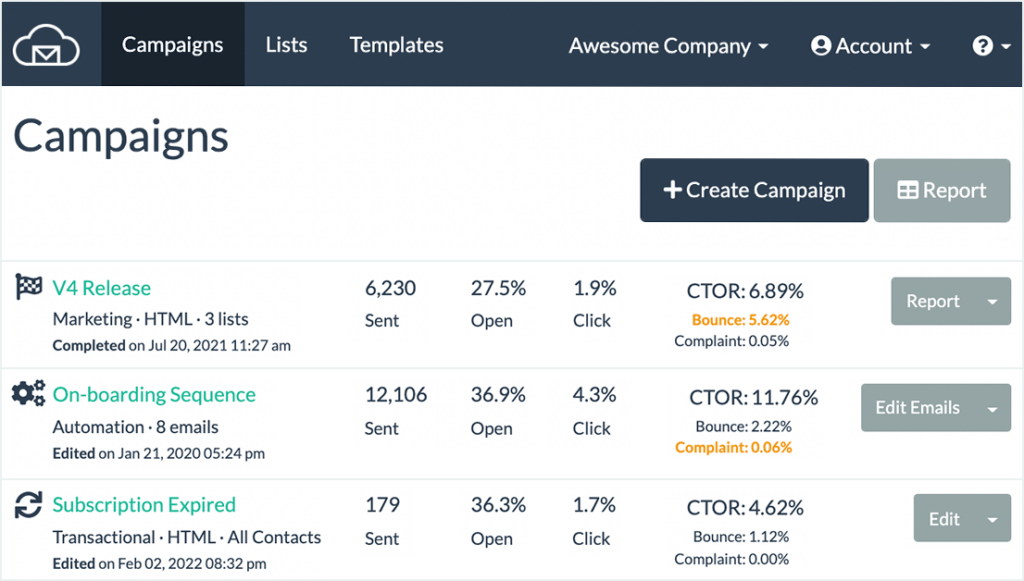
- A/B testing – Test up to 3 subject lines to compare engagement rates
- Live chat and email support (7 days/week from 8 am-8 pm EST)
- Drag-and-drop and HTML template builders – Bring your own HTML email templates, choose from a library of customizable pre-made templates, or design your own templates with a drag-and-drop builder.
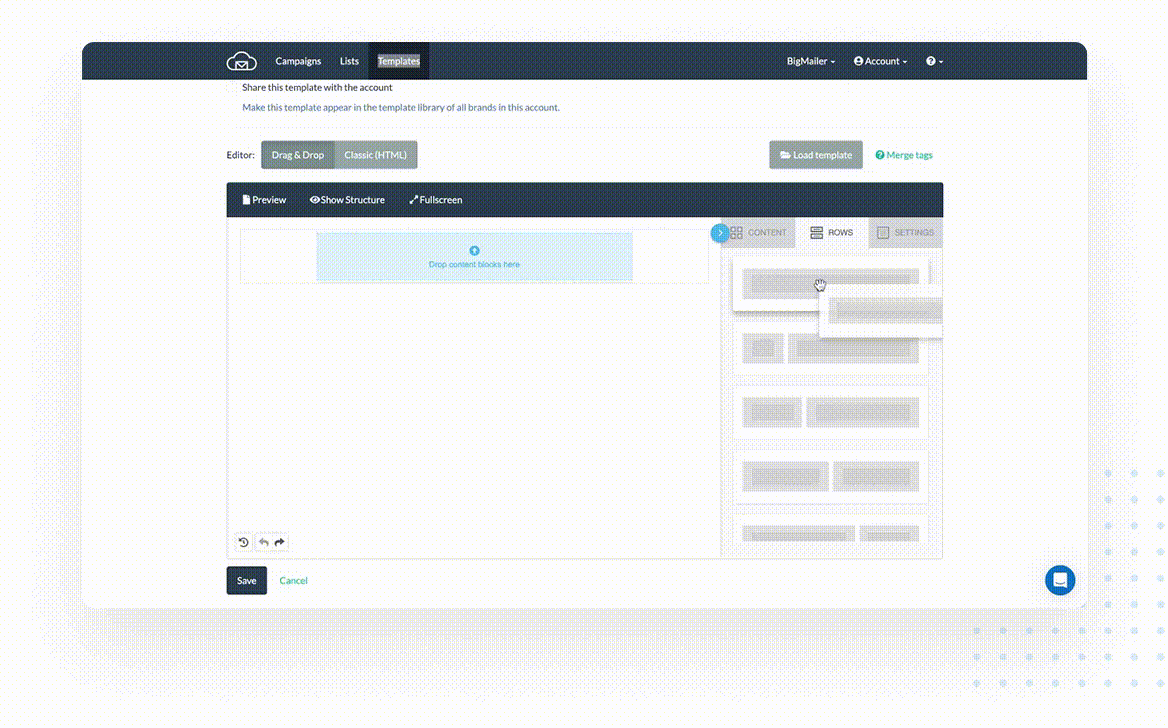
- Multi-brand management – Manage multiple brands and projects from a single platform.
- User roles and access control – Control who has access and permissions to your valuable email lists.
- Landing pages – Create landing pages to capture emails for your newsletter.
- Built-in email validation – Remove all invalid emails from your list during the import to improve your deliverability.
- Email throttling – Control the number of emails sent at a time to improve your deliverability for large lists, especially after changing providers or IP addresses.
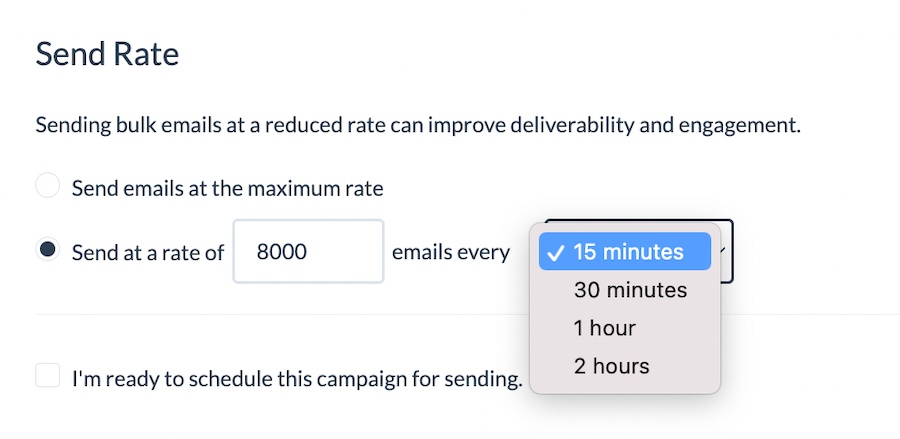
- Integrations – Sync your customer records with hundreds of apps by using integrations with Zapier, Make, Pabbly, or Zoho (or webhooks to push data into your app).
- Referral programs – Grow and monetize your newsletter through referrals by integrating with Sparkloop.
Pricing
BigMailer offers flexible and affordable pricing based on the number of contacts in your email list. BigMailer has 4 main pricing plans:
- Free Startup Plan – Up to 1,000 contacts and 5 users (Amazon SES required)
- Business Basic – $5/month per 5,000 contacts (starts at $20/month) with up to 20 users (Amazon SES required)
- Business Pro – $10/month per 5,000 contacts (starts at $20/month) with up to 20 users
- Agency Pro – $10/month per 5,000 contacts and 100 users (For 300,000+ contacts)
Note: Using Amazon SES comes with an added cost of $0.1 per 1,000 emails sent, paid to Amazon SES directly. This is one way in which BigMailer helps keep your bill more affordable if you don’t send often.
Here’s how BigMailer’s plans compare to beehiiv’s on price:
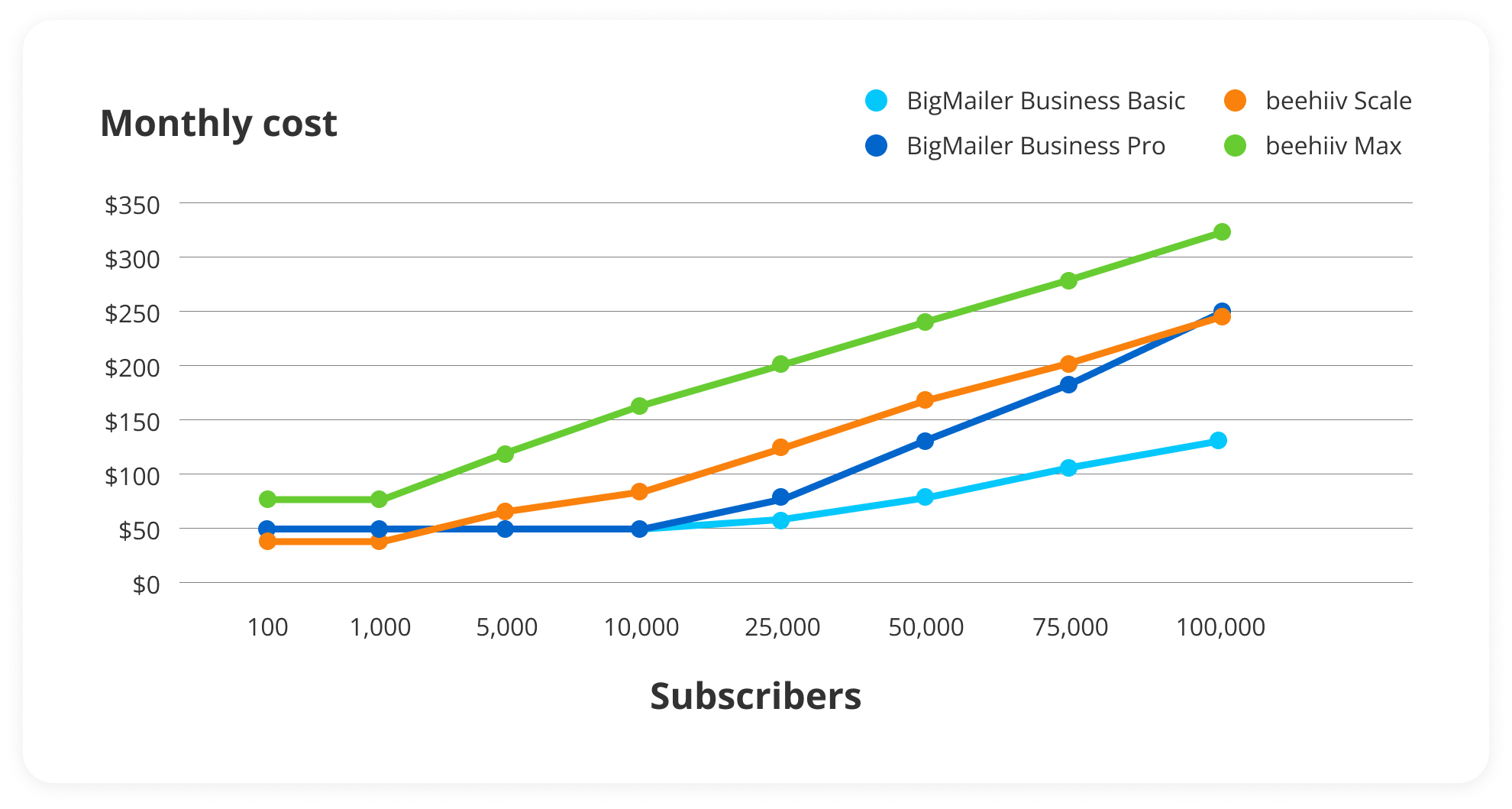
Check out BigMailer’s pricing page for more details.
Customer reviews
Customers love BigMailer’s ease of use, competitive pricing, range of features, and attentive customer support. There are very few criticisms from customers, but a few wished the template library was larger.
Here’s what one verified user has to say about using BigMailer:

Best for Publishing: Substack
Substack is an online platform for content creators and writers to publish newsletters and build a subscription-based audience. It’s strictly meant for publishing content, so you won’t be able to run your other typical email marketing campaigns, like sequences.
Substack is a good option for people who want to post their content on a platform for free without any technical setup.
Hosting your newsletter on Substack gives you access to their large network of over 20 million readers, which is an advantage for growing an audience from scratch.
Substack’s paid subscriptions is another unique feature for monetizing your newsletter without ads or sponsorships (the downside is a 10% fee). This enables you to provide a better reader experience by not interrupting readers with ads.
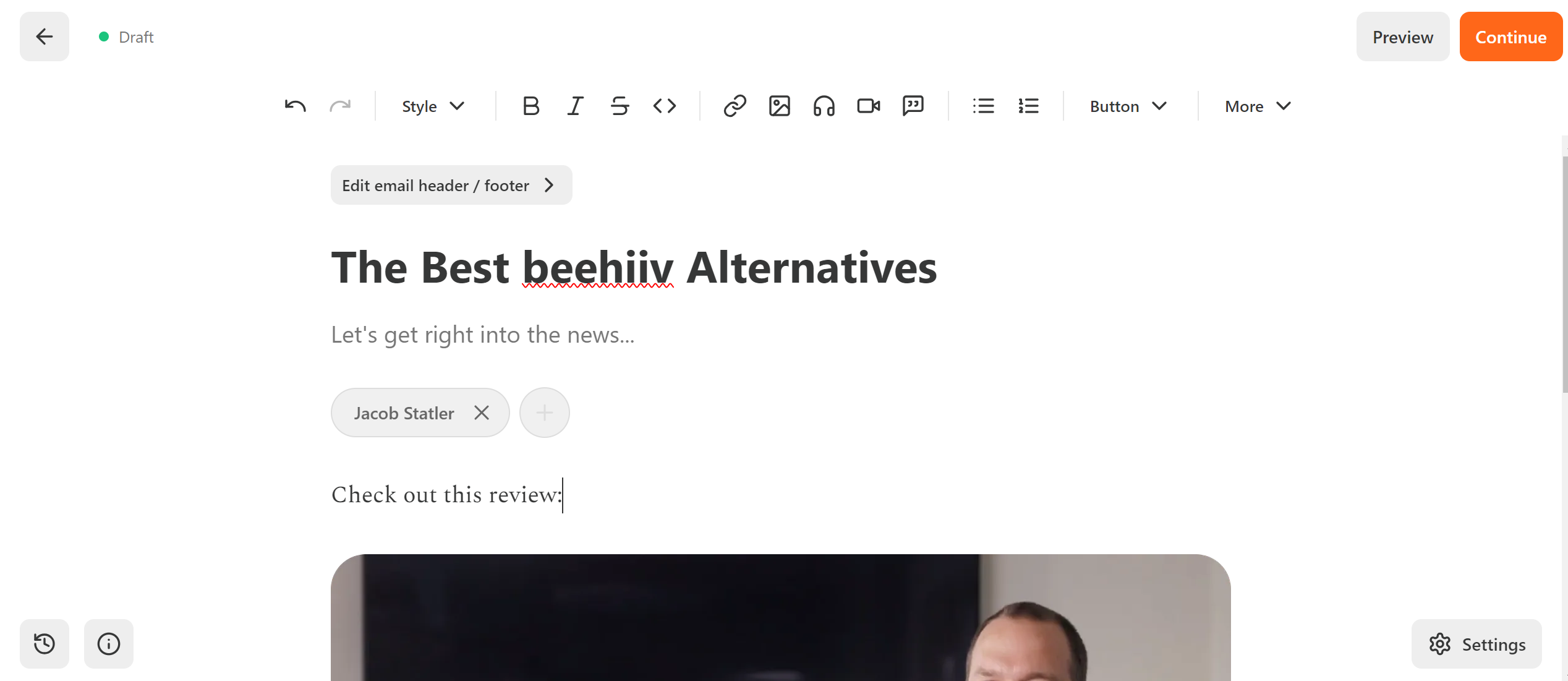
Creating newsletters in Substack is as easy as editing a Google Doc, which is a bonus if you’re looking for a positive writing experience.
Pros
- Free to use
- Fees only apply when (or if) you get paying subscribers
- No website is required to join
- Easy to use and post content to
Cons
- Very limited email automation capabilities (no sequences or drip campaigns)
- Limited customization options
- Lack of API
- Standard fee = 10% of gross subscriber revenue
- Some users complain about customer support being slow and overreliant on AI
Features
- Create and personalize a profile with a name that reflects what your channel is about.
- Users can have as many newsletters as they want, including free and paid versions.
- Monetize your newsletter with paid subscriptions.
- Blogging, emailing, and podcasting features are free to use.
- Get a custom domain to host your newsletter.
- Access growth features like mentions, cross-posts, referrals, and recommendations.
Pricing
It’s free to set up an account and get started on Substack. If you decide to turn on paid subscriptions, Substack keeps 10% of your revenue. There’s also an additional 2.9% + $0.30 per transaction fee.
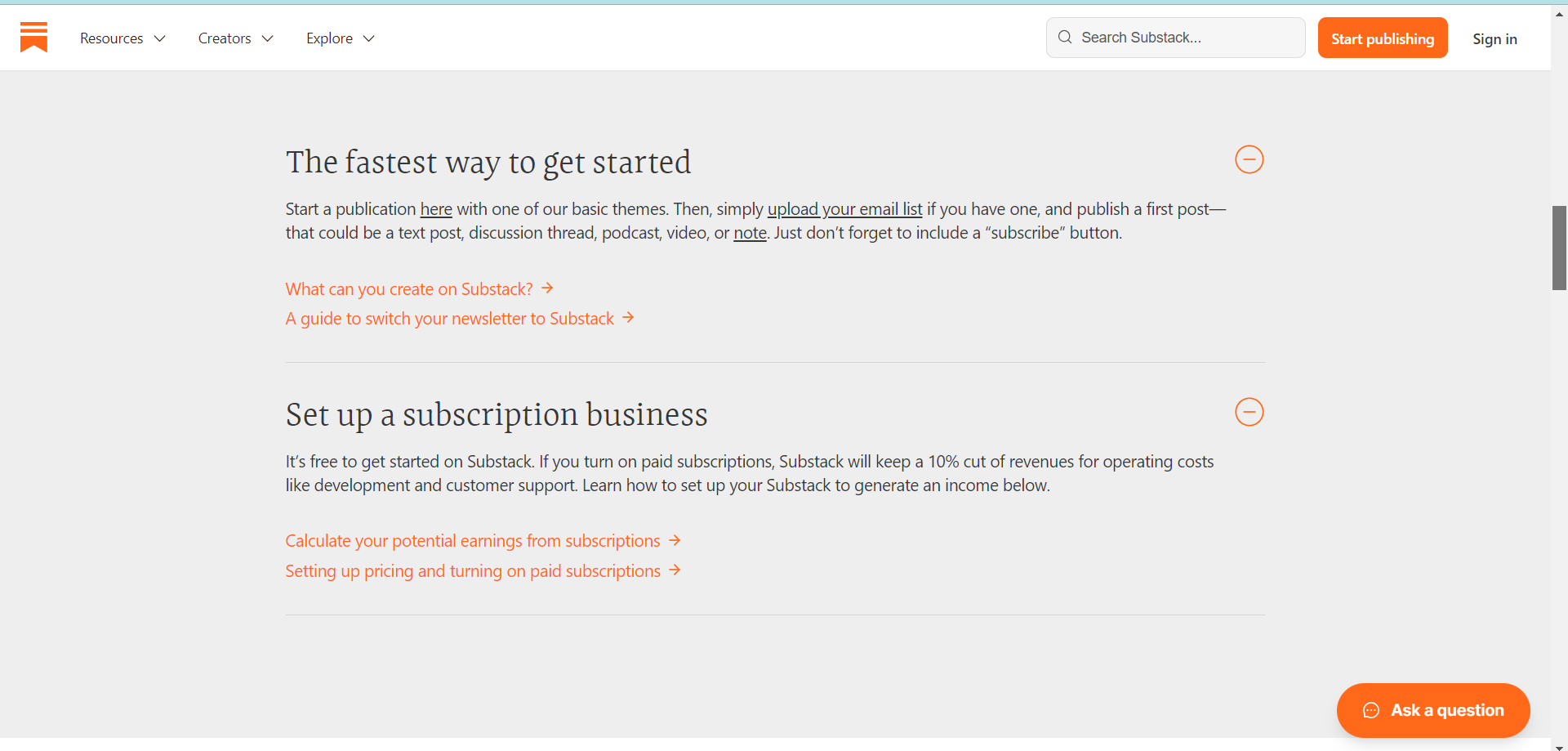
To learn more about Substack’s transaction fees, check out this page.
Customer reviews
There seem to be equal amounts of pros and cons among Substack users. Most users love how easy the platform is to use. But I also found many customer reviews that note the Substack customer service is “not present” and “they won’t respond.”
Here’s what Substack user Tim has to say:
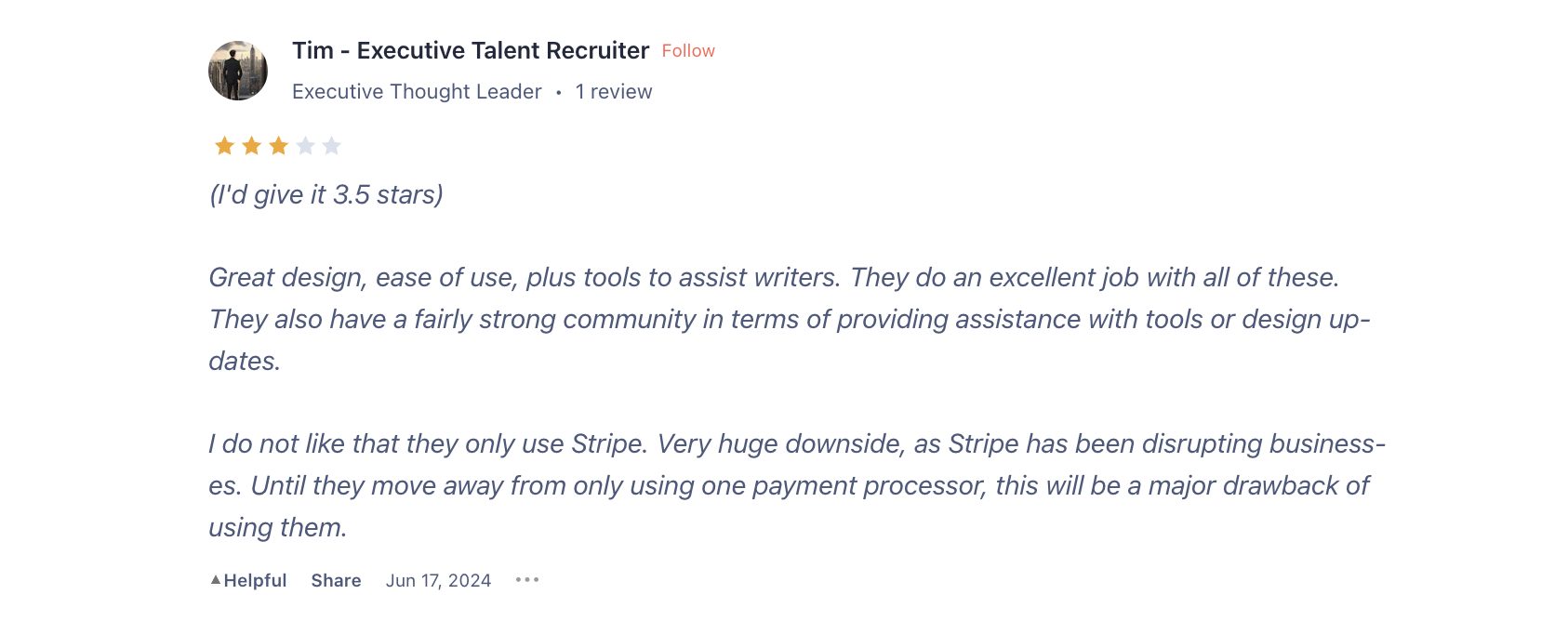
Best for Simplicity: Buttondown
Buttondown is ideal for newsletter operators who value simplicity because of its clean, easy-to-navigate interface.
It’s more affordable than beehiiv’s Max plan until you get over 10,000 subscribers. The free tier that supports up to 99 subscribers could be limiting if you’re strictly looking for the best free newsletter platform.
What I like about Buttondown is that it has some unique features that other alternatives don’t, like its ability to send newsletters directly to subscribers from your Gmail.
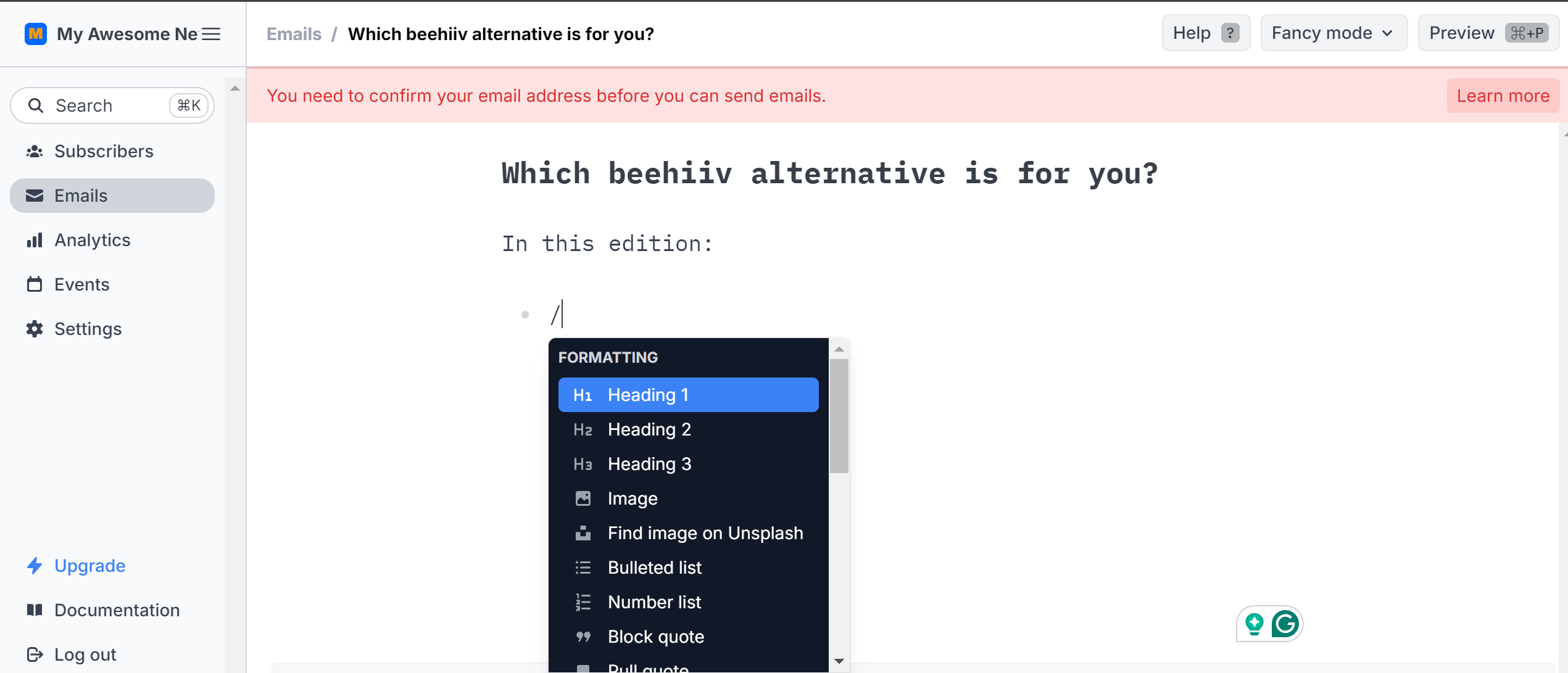
I also found the writing experience to be straightforward and quick. It’s not your typical “drag-and-drop” editor but it’s just as simple. For example, you can simply press “/” and choose the element you want to add.
The main problem you might have with Buttondown is its pricing for newsletters with over 25,000 subscribers, which becomes more expensive than beehiiv.
Pros
- Simple to use, especially for beginners
- Offers a free tier (up to 99 subscribers)
- Affordable and easy to begin using
- Noted to have quality customer support
Cons
- Some reviewers note that the email scheduling feature can be confusing
- Analytics aren’t very detailed
- Unless you’re tech-savvy, some users feel the customization capabilities are limiting
Features
- Privacy-first – Buttondown helps you remain GDPR compliant, removes link trackers, and doesn’t share your data with anyone besides yourself.
- Write in Markdown – Write in rich text or use Markdown to format your newsletters.
- Concierge migration – Customer support will help migrate your email list to Buttondown for free.
- Customer support – Talk to humans who work at Buttondown.
- API access – To connect directly to your tech stack.
- Paid subscriptions – Create paid tiers for your newsletter without paying fees (besides standard credit card processing fees).
- Analytics – Track opens & clicks, see which links bring in subscribers, and compare campaign performances.
- Comments – Enable subscribers to comment on your newsletters and connect with each other.
- RSS-to-email – Turn your newsletter into an RSS feed or turn an RSS feed into a newsletter.
- Surveys – Send out one-question surveys to your subscribers for engagement or to collect data.
- Attachments – Attach PDFs, CSVs, and other files to your newsletters.
- Integrations – Connect Buttondown directly to 45+ integrations, including Zapier.
- Send from your email system – Send newsletters directly from Gmail, Outlook, Superhuman, or another email service.
- Multiple newsletters – Manage multiple newsletters from one account.
- Webhooks – Create automations and connect your Buttondown workflows to other apps.
- Automations – Send welcome sequences and automated follow-ups to replies.
- Teams – Add users to your account to help manage your newsletter and control access with permissions.
Pricing
Buttondown offers 10 main pricing plans based on the size of your email list, including a free plan for up to 99 subscribers. Pain plans start at $9/month for 100-999 subscribers and go up to $459/month for 80,000-99,999 subscribers.
Here’s how their pricing compares to beehiiv’s:
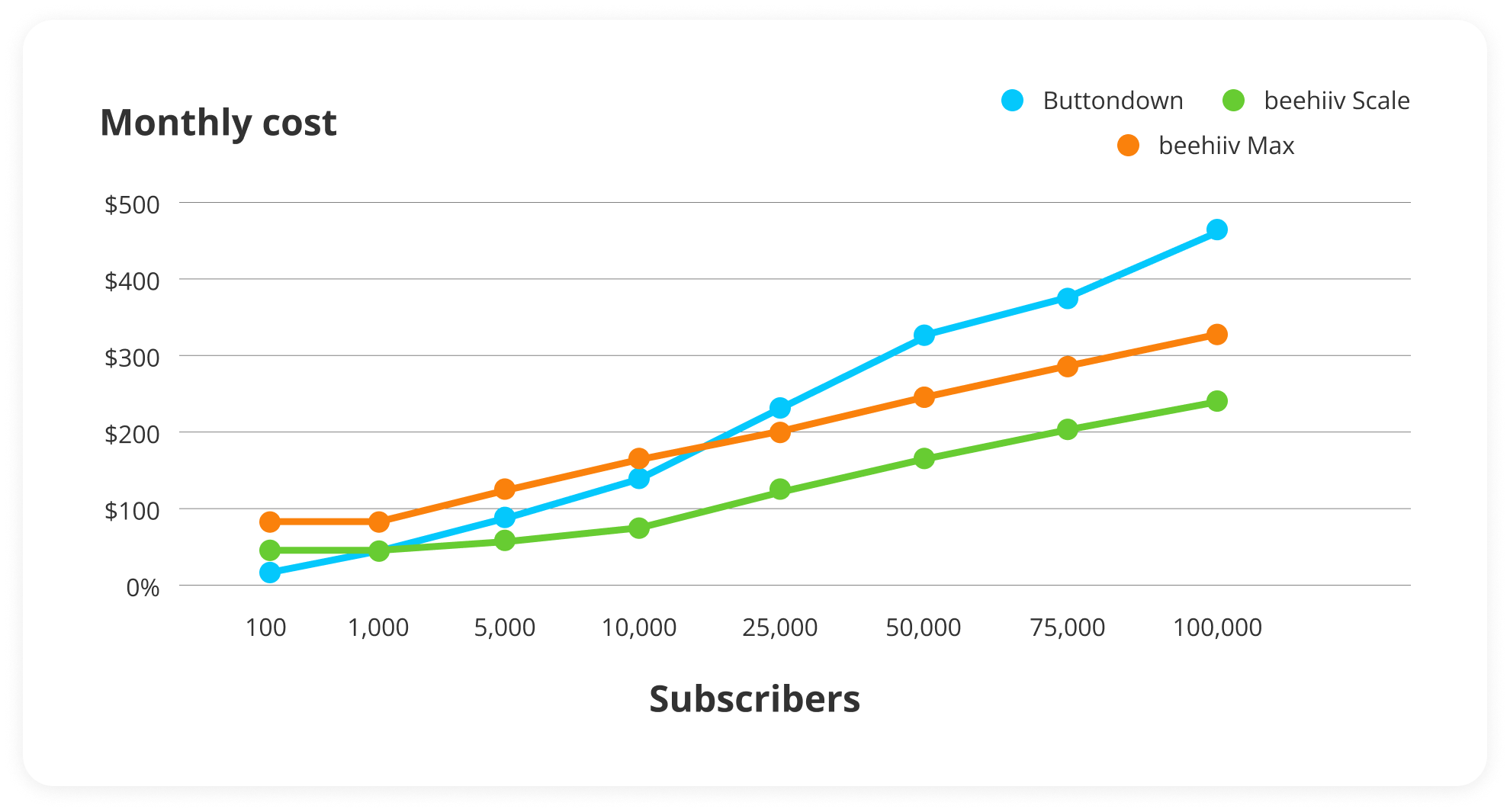
They also offer 18% off annual plans.
Check out Buttondown’s pricing page for more details.
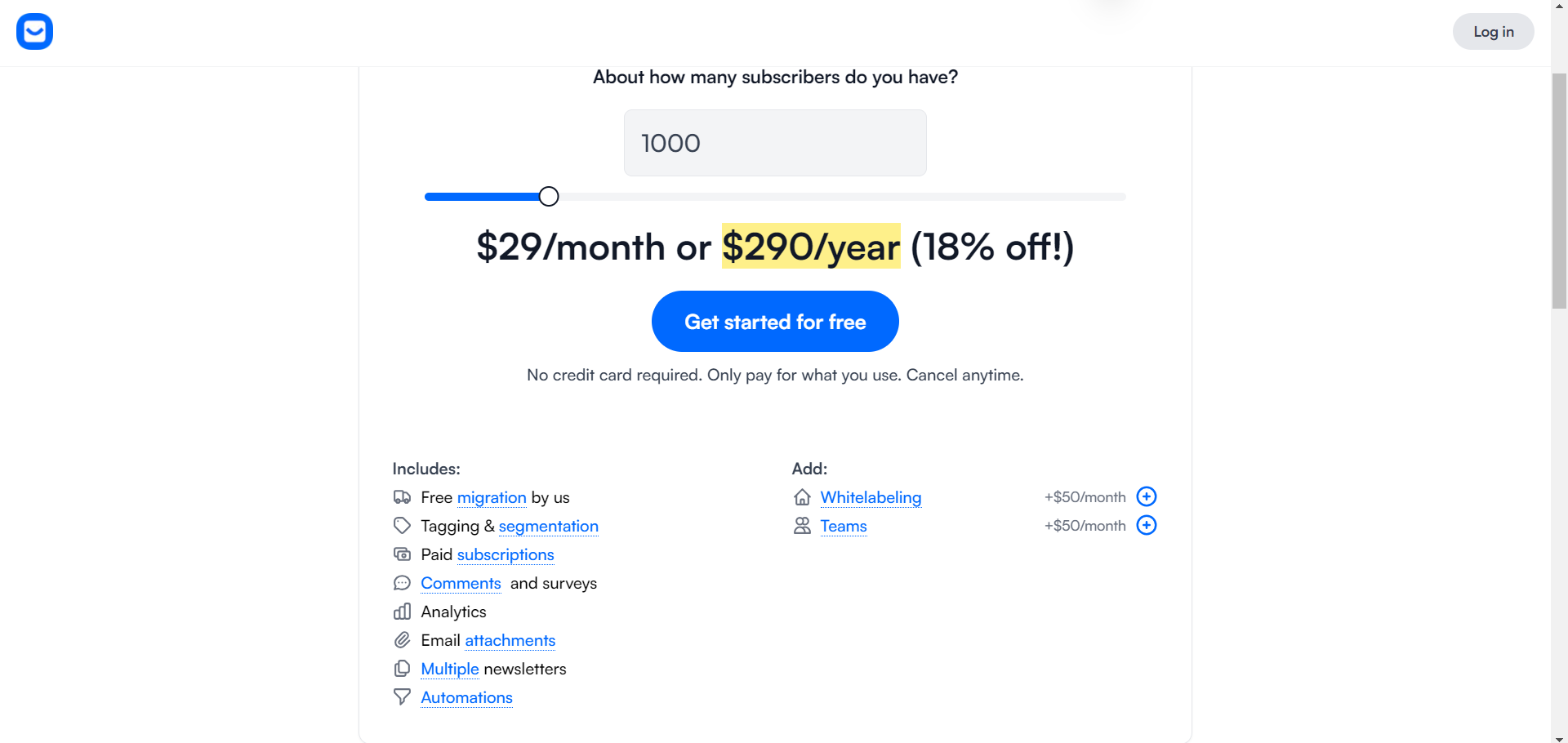
Customer reviews
Buttondown gets mostly 4 and 5 stars across online reviews. Users love that the platform is highly customizable and easy to use. I couldn’t find many customer complaints, but some mentioned the lack of detailed analytics and complex features as a con.
Here’s what Nadia O. has to say about using Buttondown: 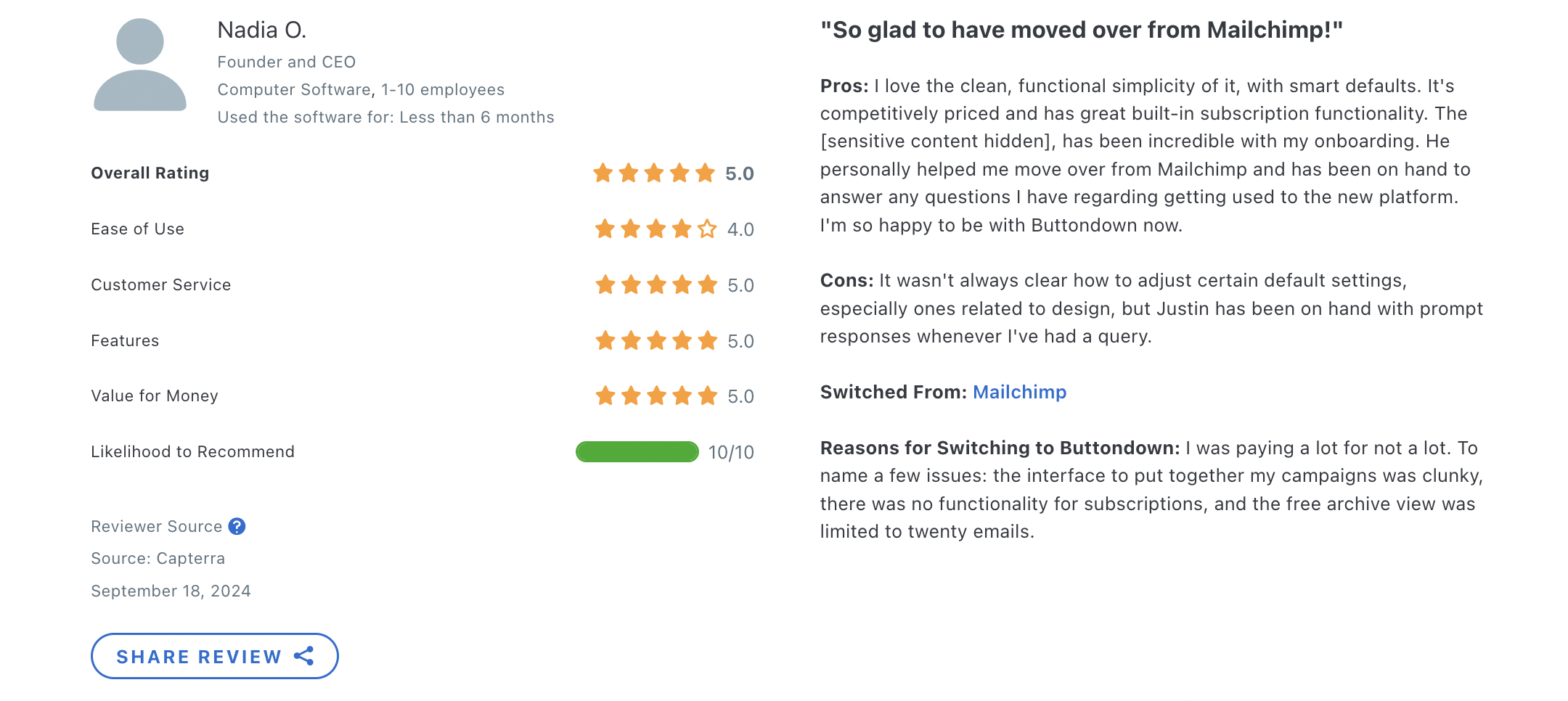
Best for E-commerce: Klaviyo
Klaviyo has become one of the most popular platforms for e-commerce brands.
It helps businesses acquire, retain, and grow their customer base with a variety of advanced direct marketing features (like SMS and mobile push notifications), including the capability to send newsletters.
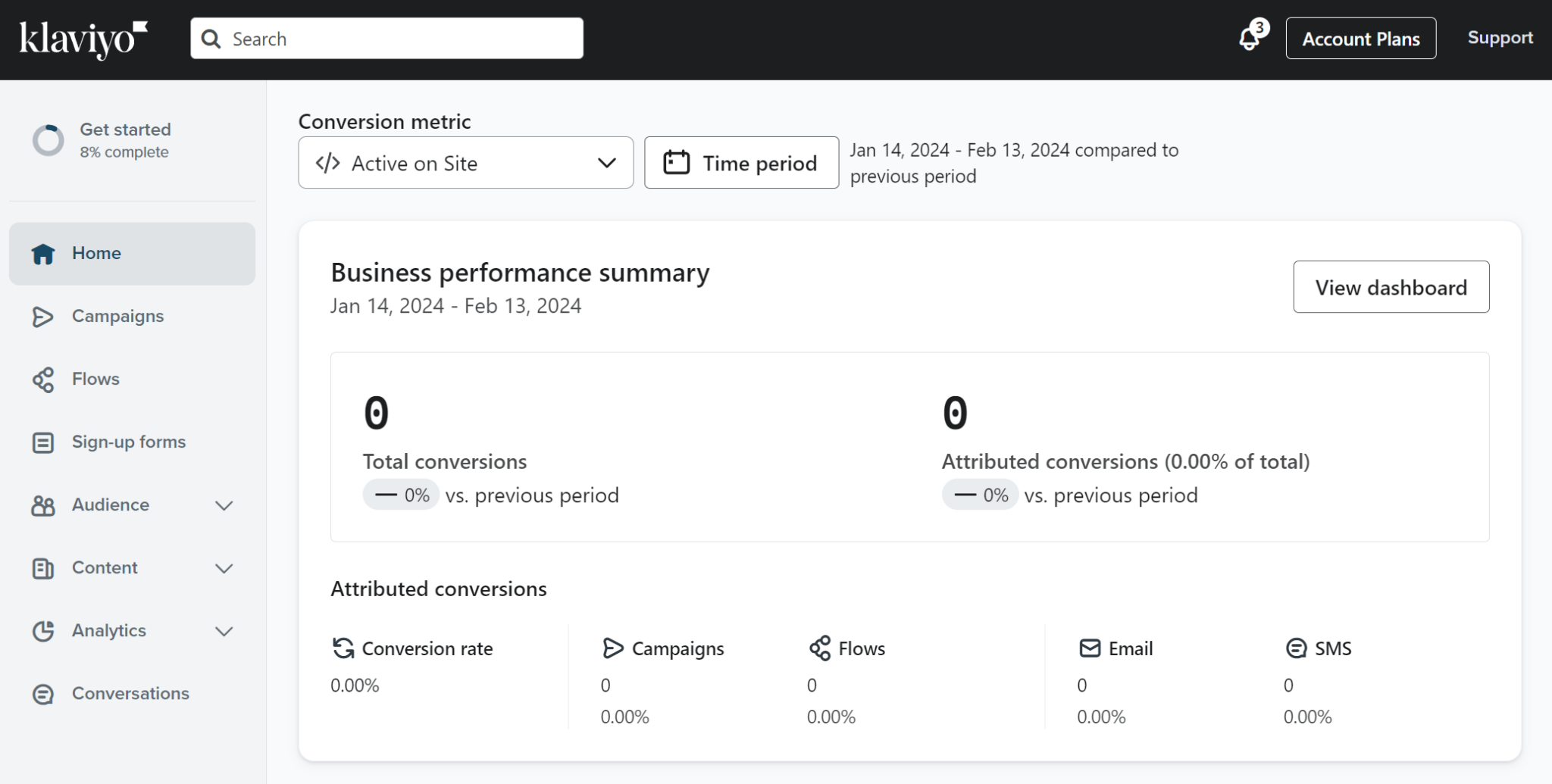
Klaviyo is a great email marketing platform for companies that need ecommerce integrations and to promote products on their website. Because of this same reason, I’d also not recommend Klaviyo for companies that aren’t doing ecommerce or are working with smaller budgets.
Their Customer Data Platform can deliver hyper-personalized emails to individual subscribers. But be prepared for high pricing (after you reach 10,000 subscribers) and a steep learning curve to utilize all of its features. 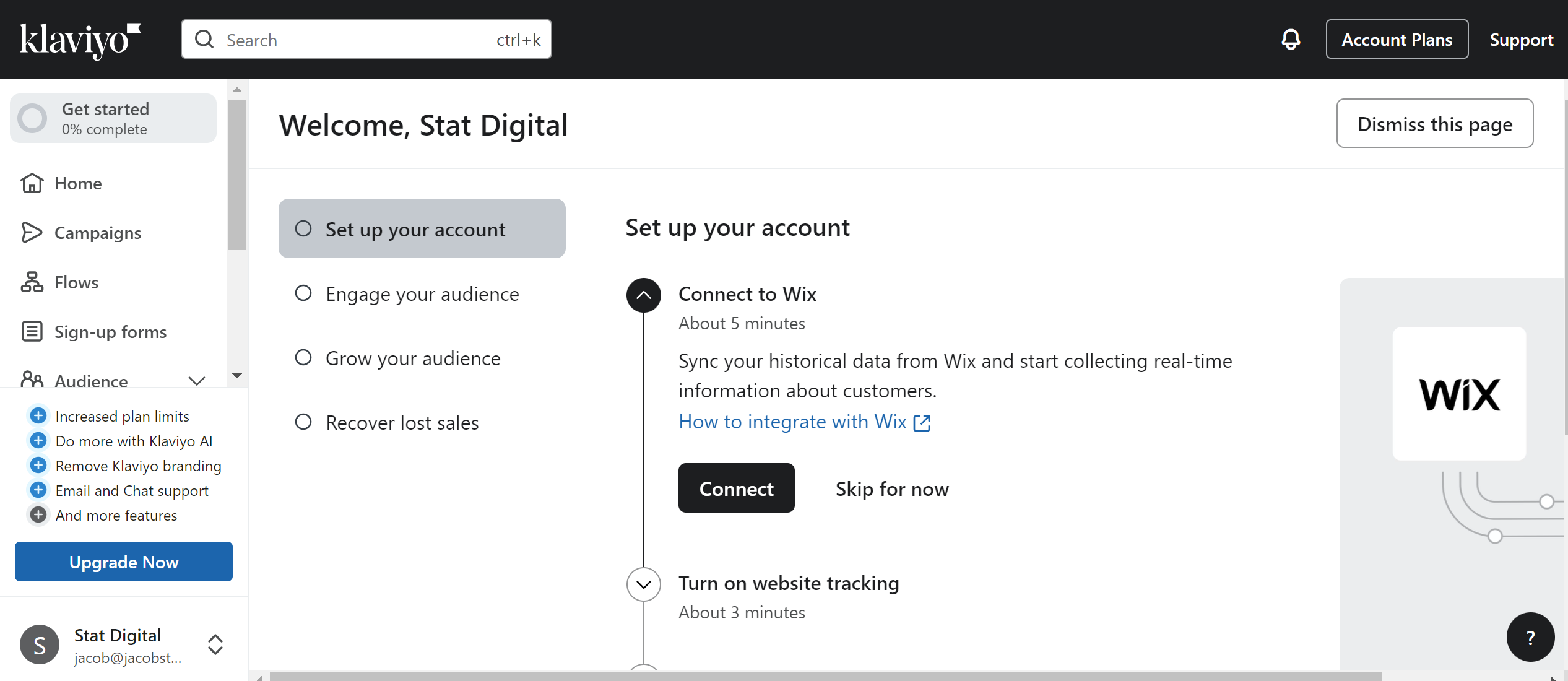
One thing that stood out to me when signing up for Klaviyo was its streamlined, step-by-step onboarding process, which is helpful since it’s a more complex platform than most beehiiv alternatives on this list.
Pros
- Also offers SMS and mobile push notifications (on a different plan)
- Customizable dashboard for reporting and analytics
- Plenty of direct integrations, especially for ecommerce
- Highly customizable across all features
- Free plan for up to 250 subscribers
Cons
- Some reviewers mention slow response times from customer support
- Pricing drastically exceeds beehiiv’s after 10,000 subscribers
- The drag-and-drop html email builder is highly customizable but a bit clunky
Features
- Automated flows – Automate emails based on when a customer takes a specific action.
- Campaigns – Send one-off emails, newsletters, promotional emails, or sequences.
- Templates – Start designing emails from Klaviyo’s template library or create your own using HTML, a drag-and-drop builder, or rich text.
- Web forms – Capture customer data and signups using multi-step forms, pop-ups, embedded forms, fly-outs (that move to the side), or small widgets that users click to expand.
- Integrations & API – Connect to 350+ built-in integrations (including ecommerce platforms and POS systems) or create your own using their open API.
- Profiles – Track customer data using a CDP that has CRM functionality.
- Segmentation – Create very specific email list segments based on things like previous purchases or predicted CLV.
- Klaviyo AI – Get predictive analytics, give personalized product recommendations, and have AI automatically create campaigns for you.
- Klaviyo portfolio – Manage multiple newsletters and control user access.
- Reporting – Integrate data from other software for holistic analysis of your email campaigns.
Pricing
Klaviyo offers over 50 pricing tiers based on your email list size. They have a free plan for up to 250 subscribers. Pain plans start at $20/month for 251-500 subscribers and go up to $2,300/month for 200,001-250,000 subscribers.
Here’s how Klaviyo’s pricing compares to beehiiv’s:
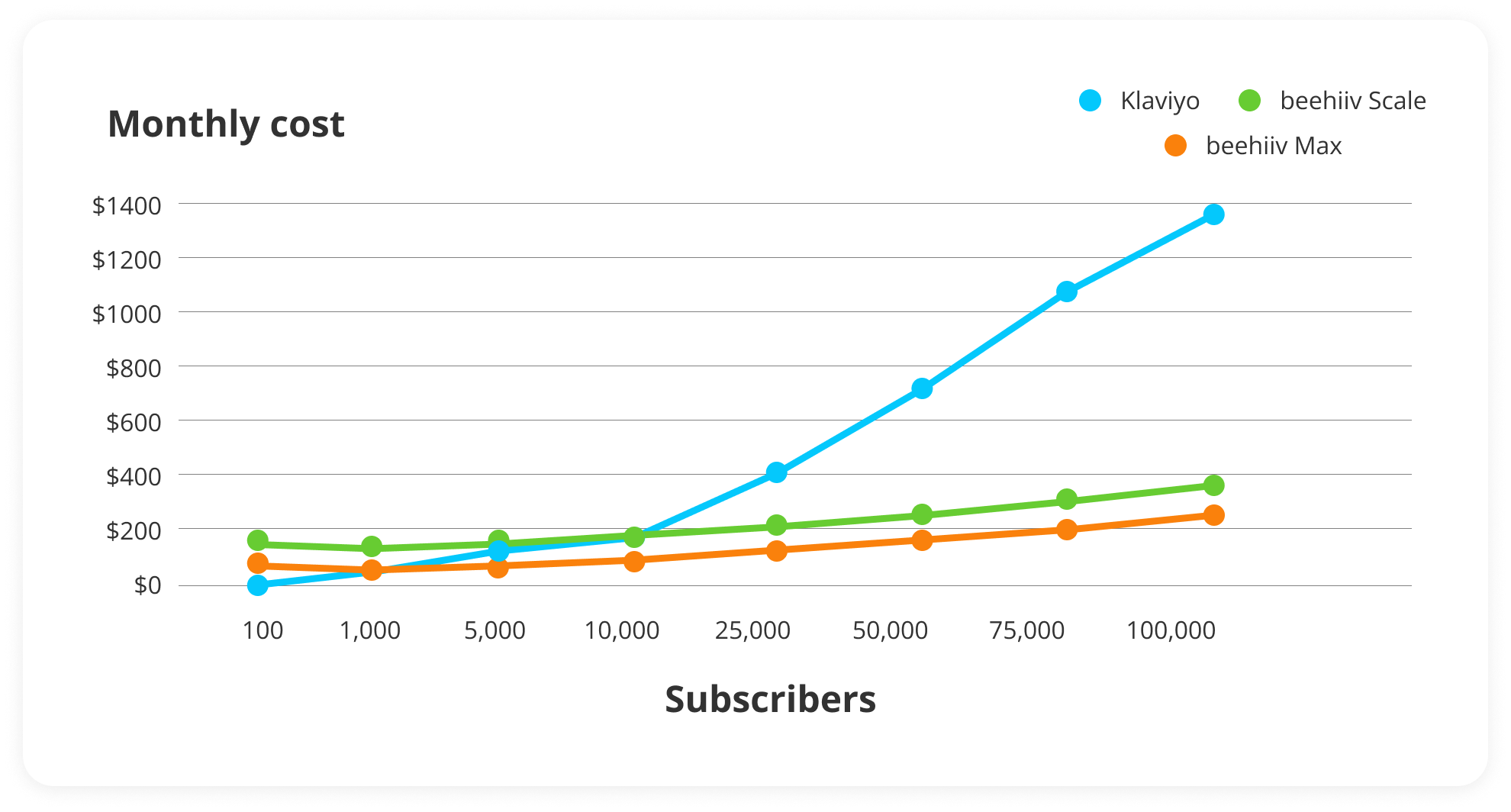
For more accurate pricing, input the size of your email list on Klaviyo’s pricing page.
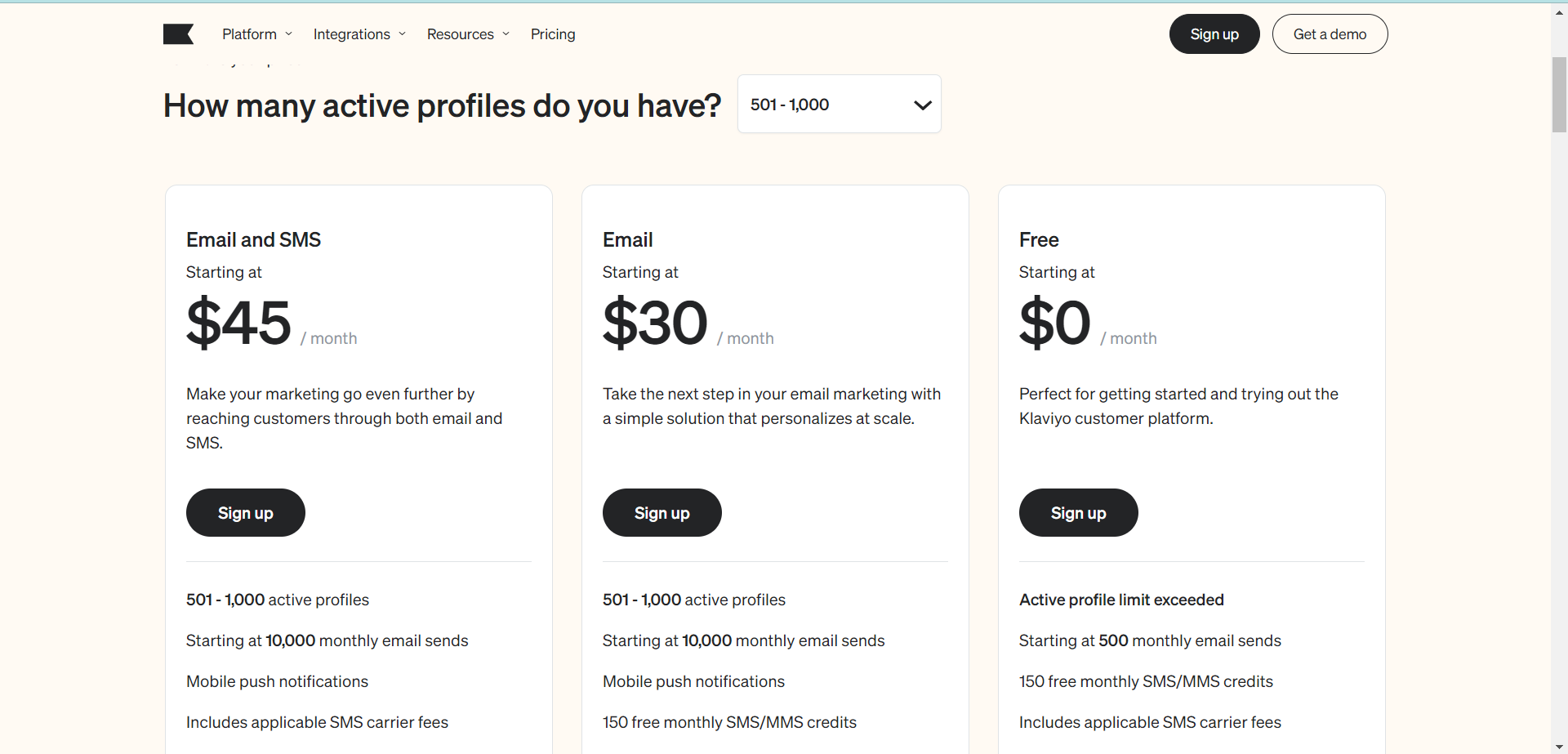
Customer reviews
Klaviyo receives 4-5 stars across most customer review websites. Customers appreciate the advanced functionality. Most customers seem pretty happy with Klaviyo, but there are a lot of reviews complaining about the high pricing and customer support.
Here’s what Madie T. has to say about using Klaviyo:

Best for Campaign Analysis: Mailercloud
Mailercloud is an email platform designed for small and large businesses.
It’s known for being an all-around email marketing platform, so it goes beyond newsletters. This could be good if you’re planning on sending other types of email campaigns, but this could also mean that you’ll pay for features you don’t need.
Mailercloud is more cost-effective than Beehiiv until you hit the 25,000 subscriber mark. Then, it becomes more expensive.
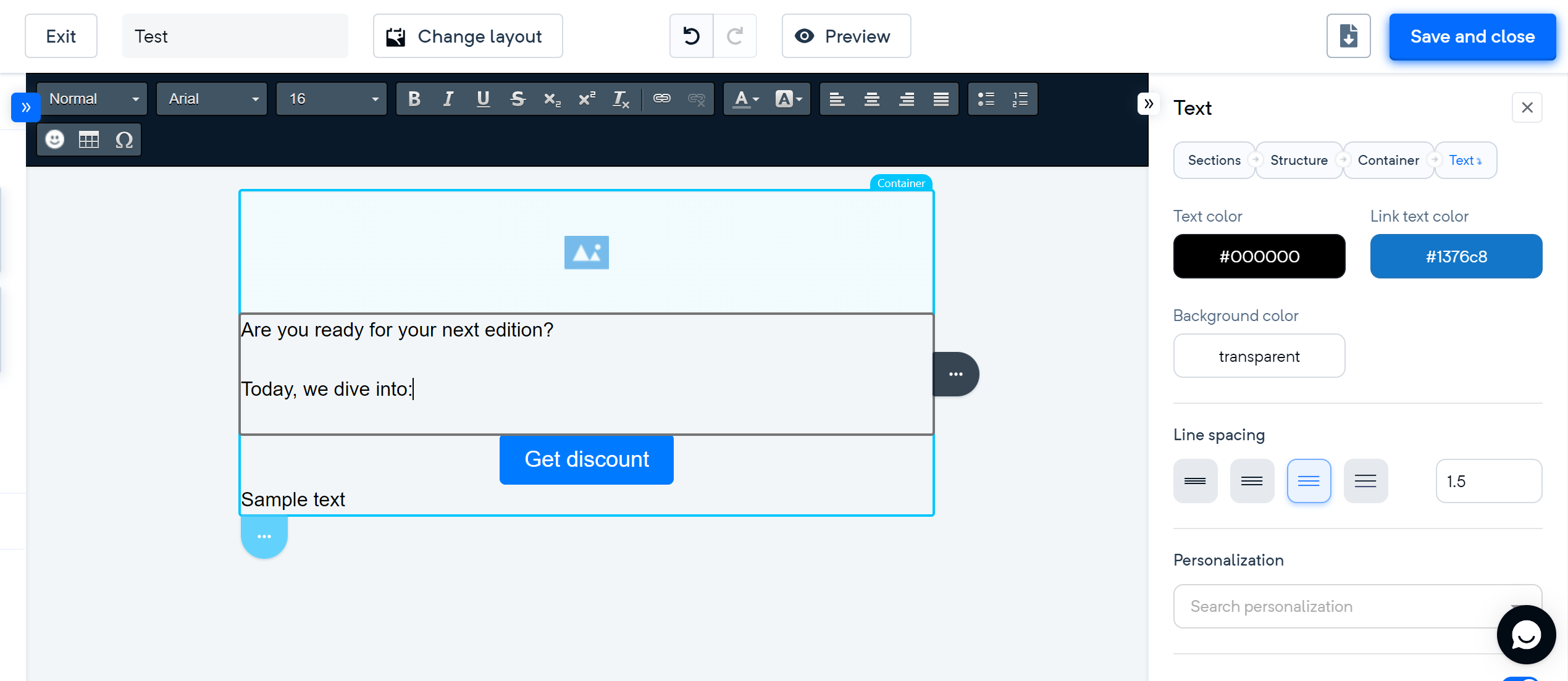
I found Mailercloud’s UI to be easy to navigate, and designing emails with their drag-and-drop builder was very customizable but a bit clunky.
You can also send unlimited emails, which could be useful for companies that need to constantly send newsletters promoting their products.
Pros
- User-friendly interface
- Competitive pricing for small and medium-sized businesses (especially for under 50,000 subscribers)
- Comes with a lot of automation features
- Reviewers give them kudos for caring customer support
- Unlimited emails for Premium and Enterprise accounts
- Free for up to 1,000 subscribers
Cons
- Some customers report bugs on the platform, such as automations stop working and images don’t display properly
- Customer support is based in India, so there could be a delay in customer support if you’re based in the USA
- Some customers note a learning curve for all of their features
Features
- Regular campaigns – Create and schedule one-off emails or automated campaigns.
- Autoresponder – Automatically trigger emails based on actions by subscribers.
- Email automation – Create customized email sequences based on triggers.
- A/B testing – Create multiple variations in 2 different emails to compare performance.
- Drag-and-drop builder – Design emails with a simple drag-and-drop interface without coding.
- Custom HTML editor – Customize your email templates with HTML code.
- Template gallery – Choose from an email template library, then customize it to your liking.
- Personalization – Insert custom fields and send emails in the receiver’s time zone.
- Contact monitoring – Import email lists and add up to 100 data fields per contact.
- Segmentation – Organize your email list into groups based on common characteristics and behavior.
- Contact rating – Score contacts based on how much they engage with your emails.
- Form builder – Create embedded forms, pop-ups, landing pages, banners, and sliding boxes to capture emails.
- Blacklist monitoring – Check for broken links and blacklisted domains in your email content to prevent deliverability issues.
- Advanced reports – Get downloadable reports for all of your email campaigns.
- Multiuser permissions – Add team members to your account while controlling access and permissions.
- Integrations – Connect to 20+ integrations, including Zapier and Hubspot.
- Webhooks – Trigger automations and connect your data with other applications.
Pricing
Mailercloud offers a free plan for up to 1,000 subscribers, a premium plan that’s priced based on your number of subscribers, and an enterprise plan with custom pricing.
Paid plans start at $10/month for 1,001-2,499 subscribers and go up to $1,360/month for 400,000-419,999 subscribers.
Here’s how Mailercloud’s pricing compares to beehiiv’s:
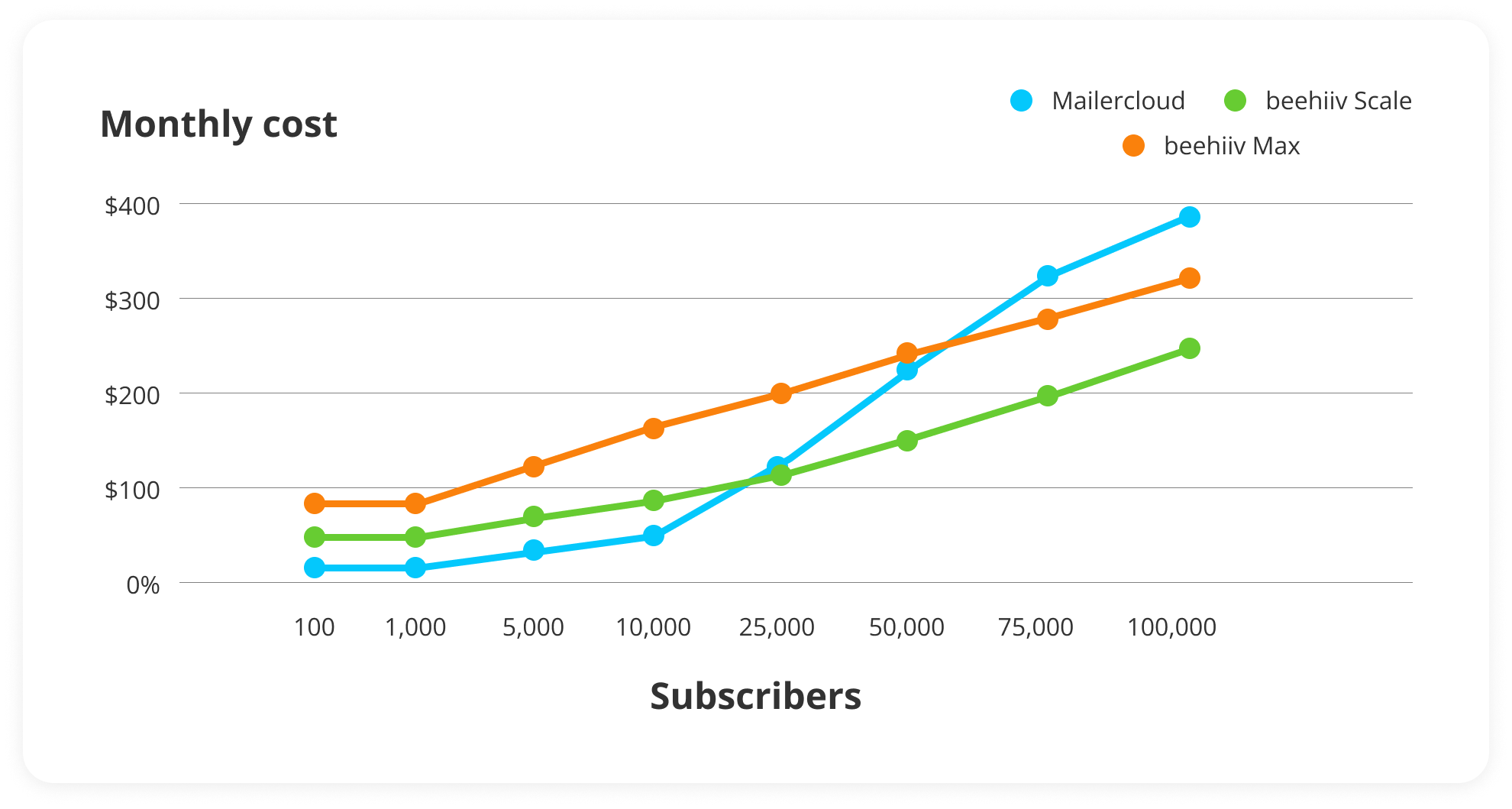
They also offer annual pricing for a 30% discount.
Check out Mailercloud’s pricing page for more accurate details.
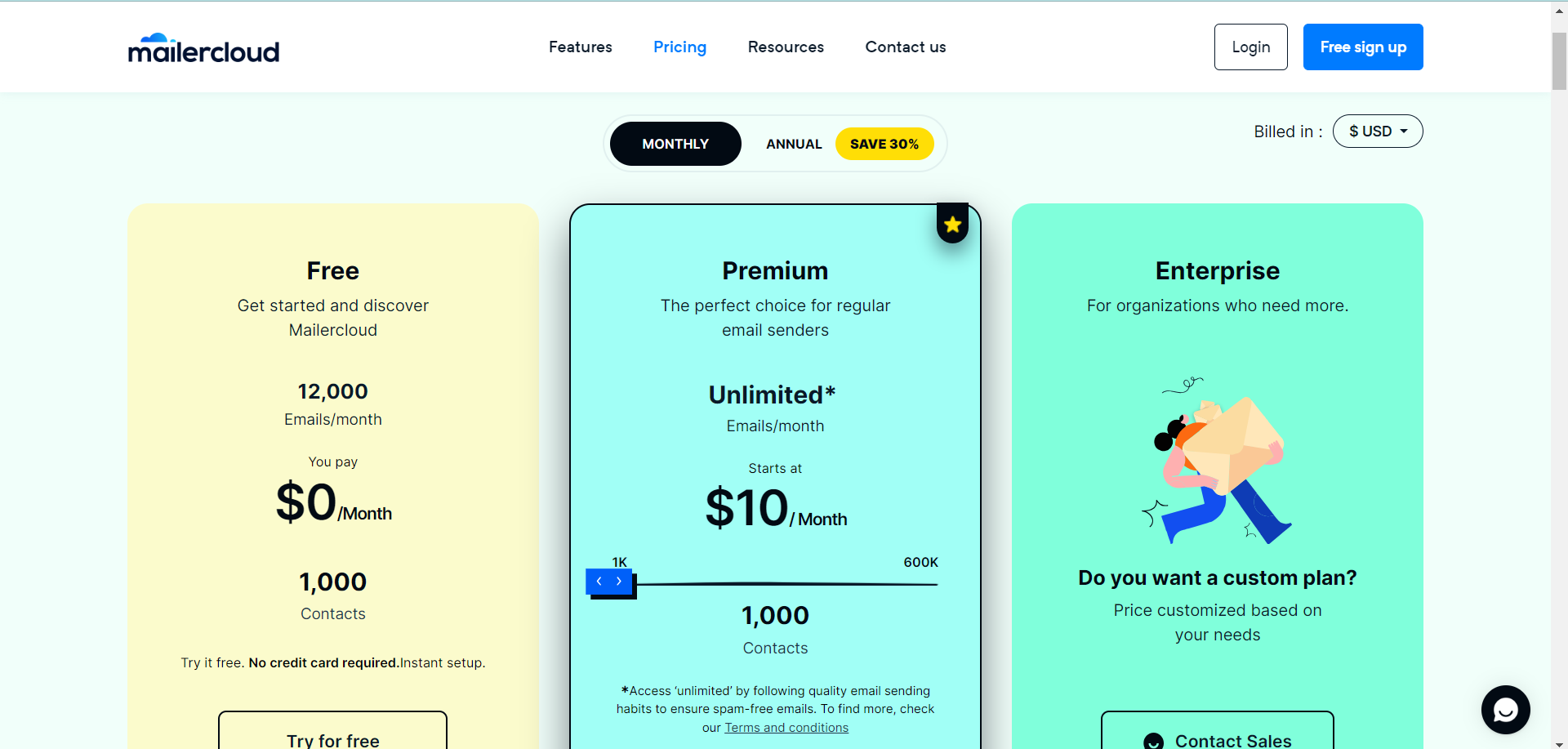
Customer reviews
Mailercloud receives 4-5 stars across most review platforms. Overall, users find Mailercloud easy to get started with. But in some more critical reviews, users mention bugs that stop their automations.
Here’s how Diane F. sums up her experience with Mailercloud:
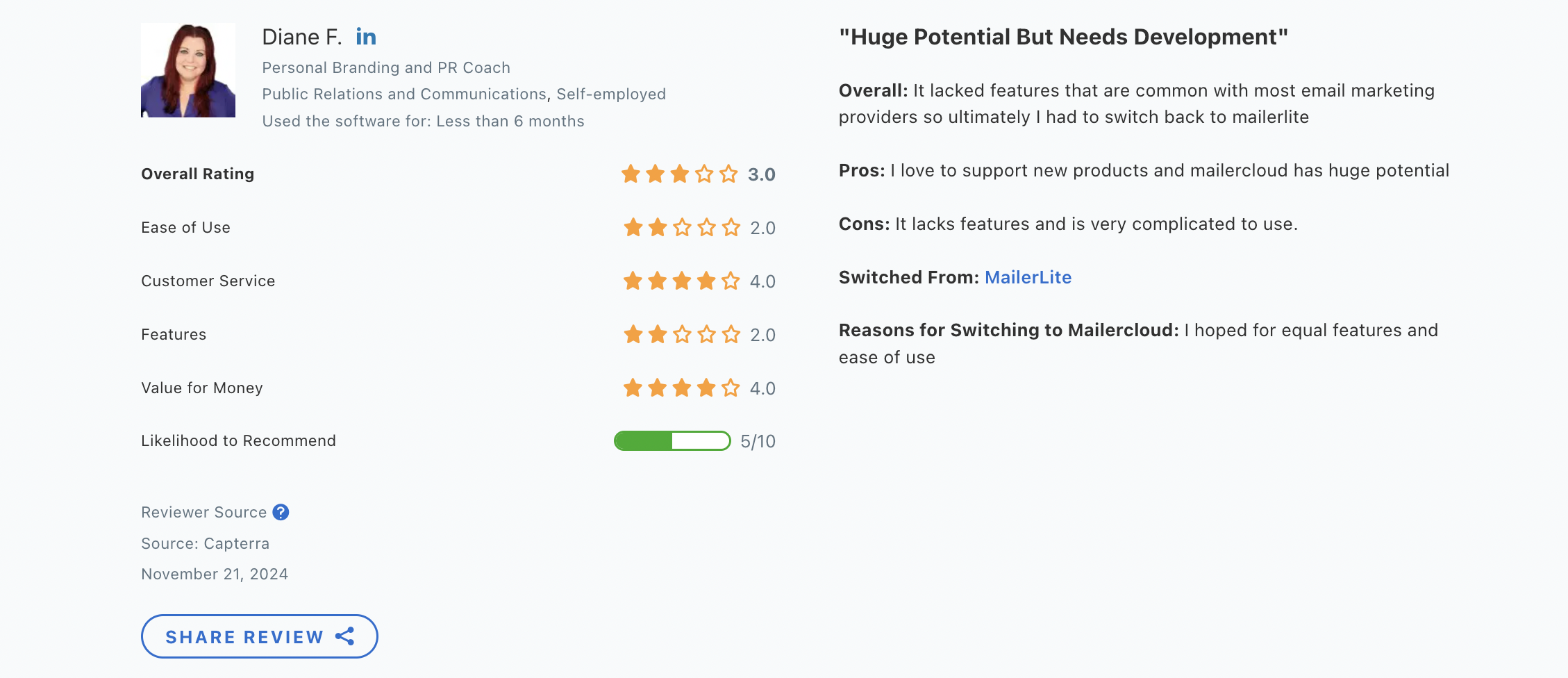
Best All-In-One: Mailchimp
Mailchimp is known for its 500-subscriber free plan that offers a variety of features, such as marketing automation and website building.
But there is a caveat: Mailchimp is also noted for frequent updates that continue to take away features from the free plan. Customer support responsiveness varies, mostly because the type of support you receive is based on what plan you’re paying for.
For the most part, Mailchimp’s paid plans are going to be more expensive than beehiiv. However, their standard plan still has a better value for up to 10,000 subscribers.

I’ll also say they had one of the more intuitive email template builders on this list.
Plus, they have plenty of integrations for ecommerce companies like Shopify and WooCommerce.
Pros
- Acts as an all-in-one mini marketing platform
- Clean interface with a simple but powerful editor
- Many integration options
- New features are continuously added
- Good for small businesses with small customer lists
- Free for up to 500 subscribers
Cons
- High-cost subscription plans
- Some users mention being charged for unsubscribed or inactive contacts
- Free plan no longer includes email scheduling and only offers support for the first 30 days
Features
- Reporting & Analytics – Create custom reports and get email & audience dashboards.
- Automated Customer Journeys– Create your own automated sequences or use Mailchimp’s pre-built journey.
- Generative AI – Generate email content and optimize campaigns with AI.
- Custom-coded and pre-designed templates – Code your own HTML email templates or get started from a template library.
- Forms & Landing Pages – Create forms and landing pages to capture email subscribers.
- A/B Testing – Test different variations of your emails like subject lines, design, and send times.
- Dynamic Content – Create one design template and customize it for different list segments.
- Advanced Segmentation – Segment your email list based on unlimited conditions.
- Behavioral Targeting – Use behavioral data to create list segments.
Pricing
Mailchimp has 4 main email marketing plans that increase in price based on the number of contacts you have.
The free plan is limited to 500 contacts. Paid plans start at $13/month for 500 contacts and go up to $1,600/month for 200,000 contacts.
Here’s how Mailchimp’s pricing compares to beehiiv’s:
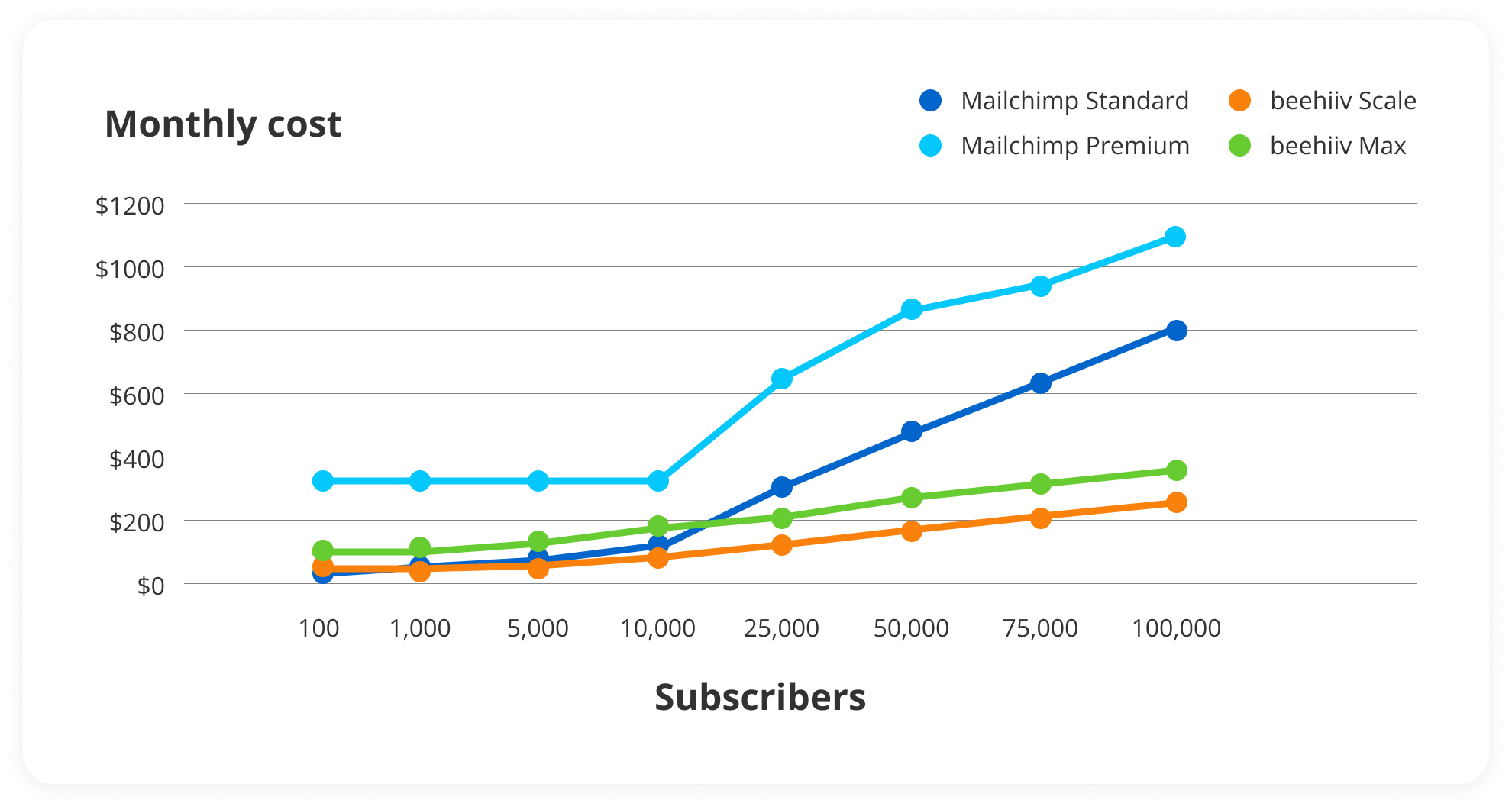
For more accurate details, check out Mailchimp’s pricing page.
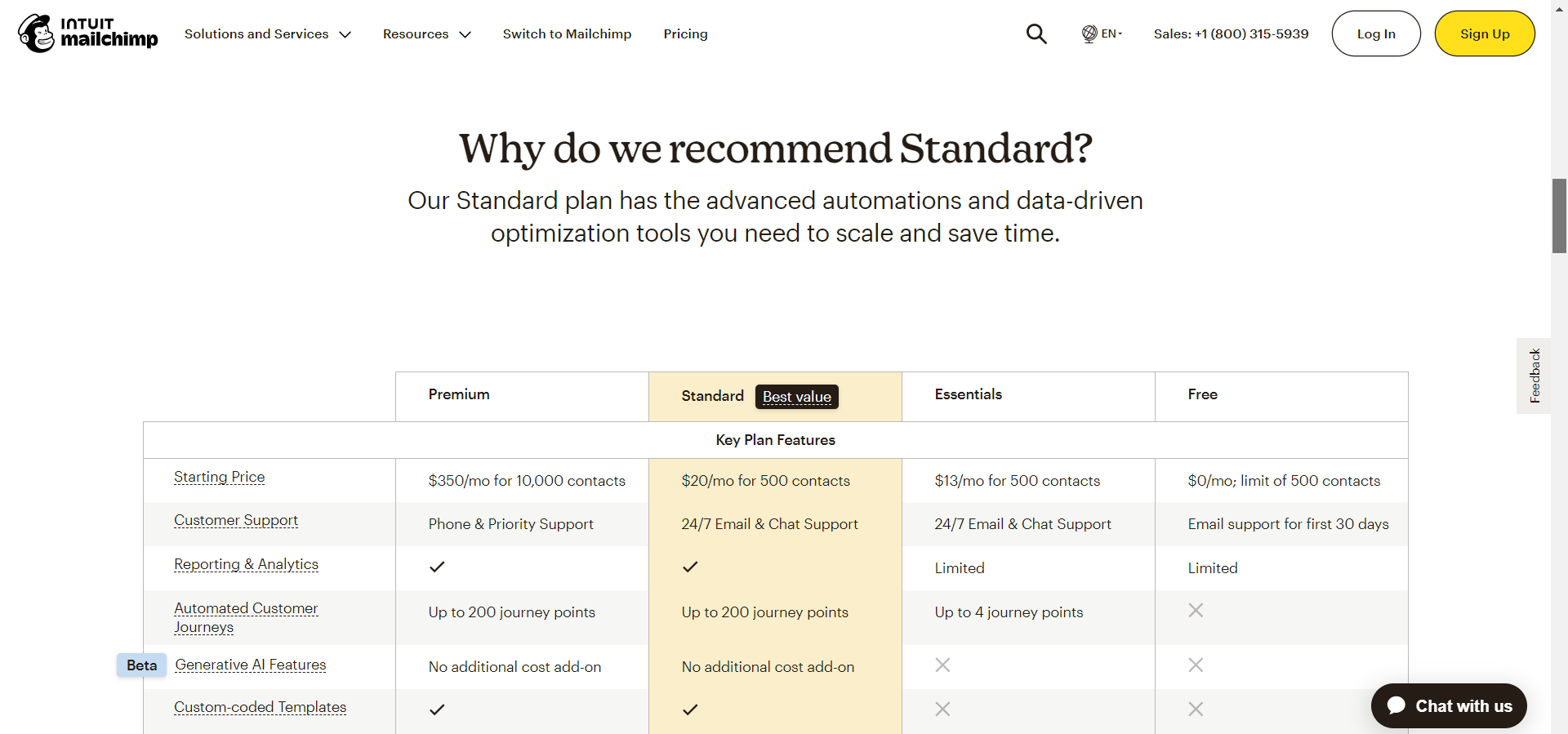
Customer reviews
Mailchimp receives 4 and 5-star ratings across most review platforms. Users like having one centralized platform to build, launch, and analyze their marketing campaigns. More critical reviews mention that customer support is slow.
Here’s what Christian E. has to say about using Mailchimp:
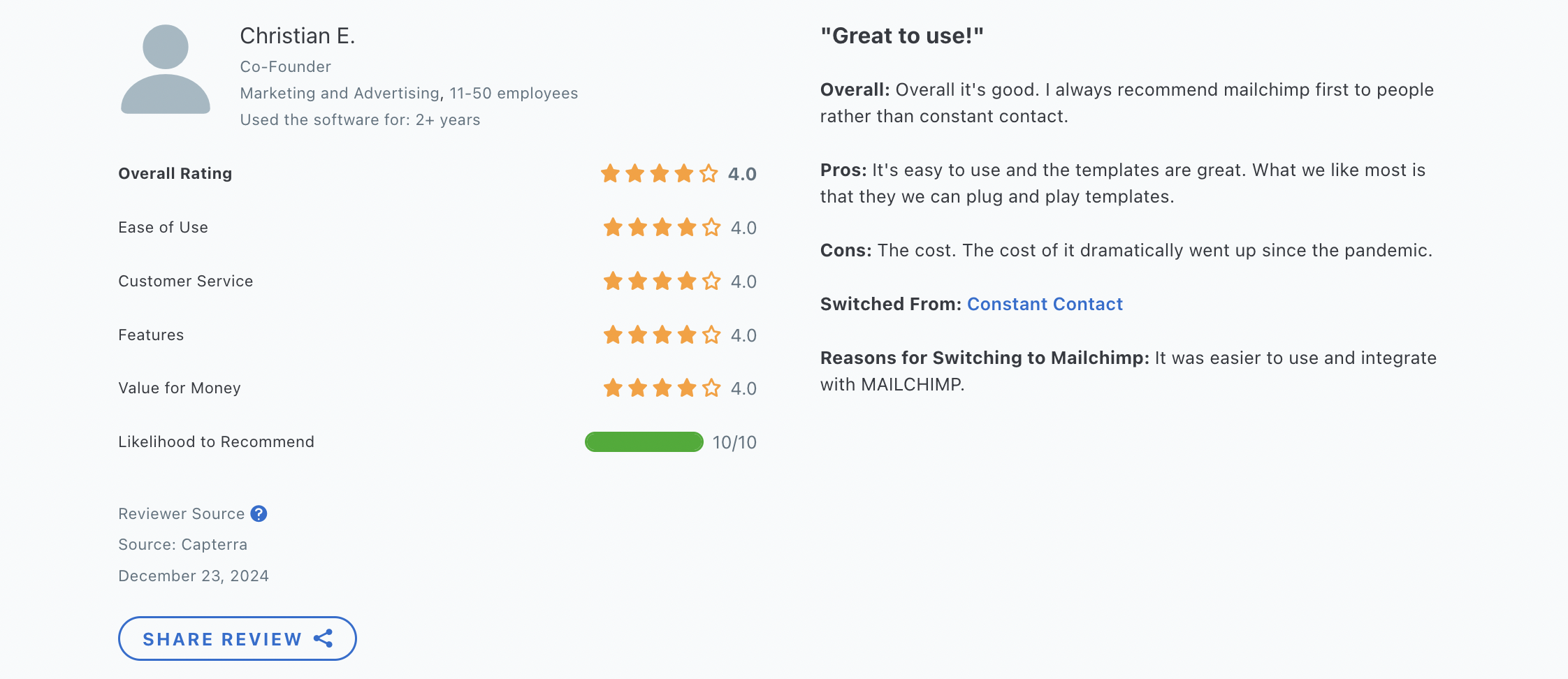
Best for Bloggers: Ghost
The Ghost platform is known for its ability to customize themes, which gives you complete control over the design of your site and newsletter.
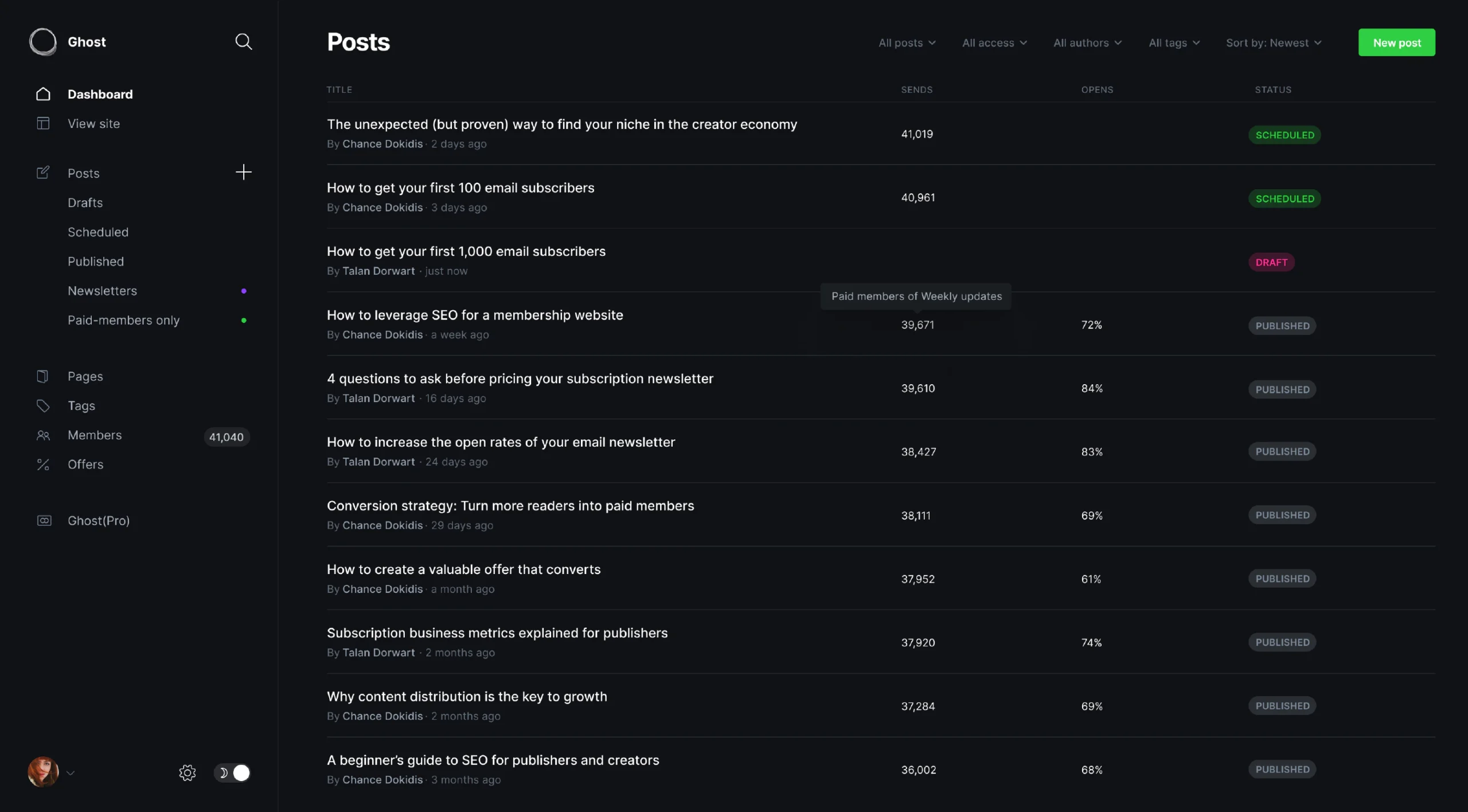
Ghost could be a good option for your newsletter if you plan on starting a blog and newsletter publication.
Its pricing is comparable to beehiiv’s until you get over the 25,000 subscriber mark. Then, it becomes drastically more expensive.
Because of this, I wouldn’t recommend Ghost if you already have a website, so you don’t have to pay for a feature you don’t need.
However, if you’re looking to start a paid subscription newsletter, this could be a good option because they don’t charge fees for that.
Pros
- Helpful if you also want to start a blog
- Extensive publishing and content tools
- UI is clean and uncluttered, which allows for easy setup for beginners
- No fees for paid subscribers
Cons
- Becomes more expensive than beehiiv after 10,000-25,000 subscribers, depending on your plan
- There’s only a credit-card-required 14-day free trial, not a free plan
- Some customers complain that the admin API is limiting and difficult to use
Features
- Site design – Create a custom website for your blog with the help of templates.
- Advanced creator tools – Publish to your website or newsletter and create content using Markdown and rich media.
- Grow your audience – Get subscribers to sign up for free or offer paid subscriptions.
- Membership management – Get insights into your subscribers and what content they’re engaging with.
- Offers & promotions – Run special promotions and offer discounts to encourage paid subscribers.
- Integrations – Connect your tech stack with over 50 integrations, including Google Analytics and Zapier.
Pricing
After your 14-day free trial, you’ll need to upgrade to a paid pricing plan.
Pricing plans start at $11/month for 500 members and go up to $3,019 for 385,000 members.
Here’s how Ghost’s pricing stacks up against beehiiv’s:
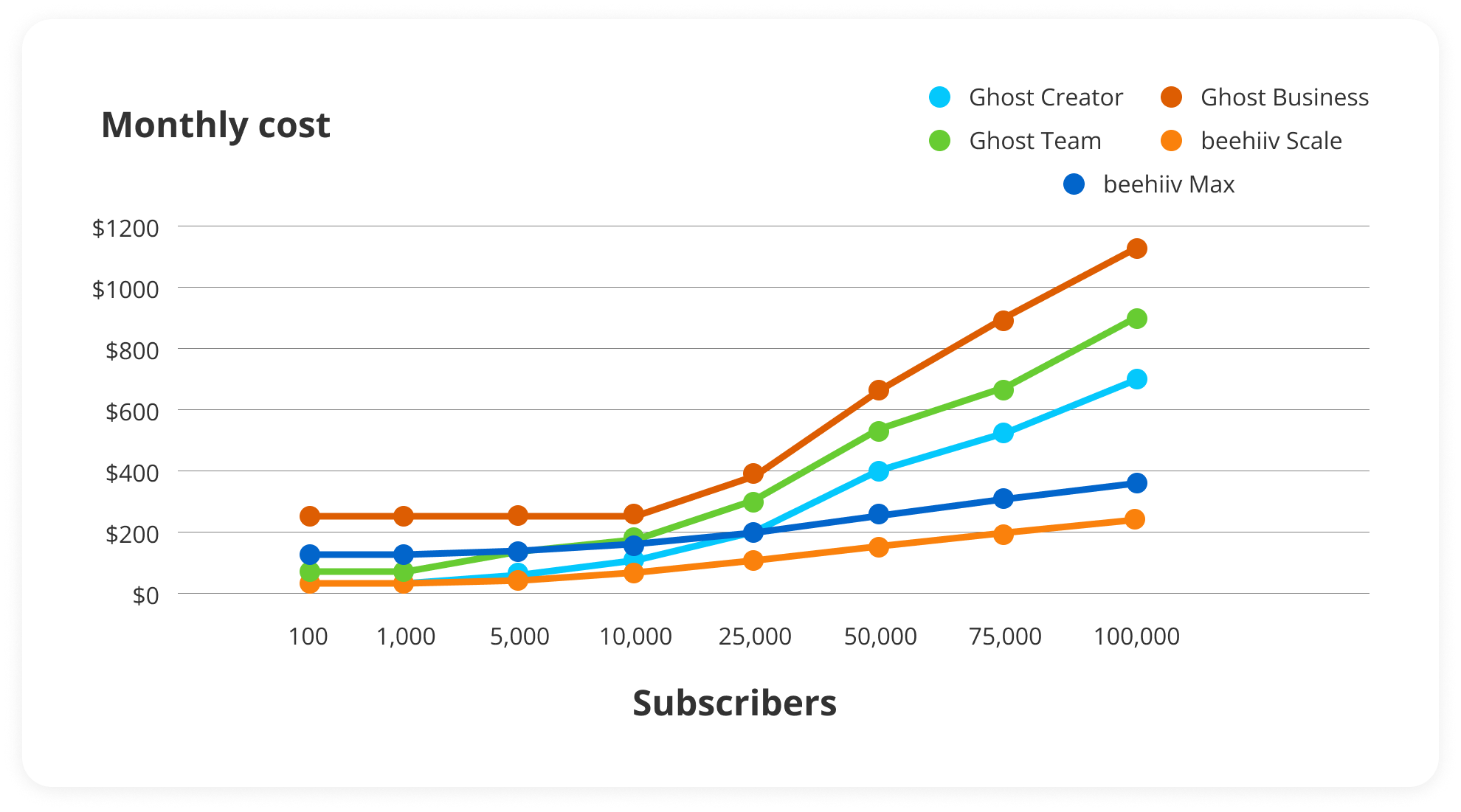
They offer about a 20% discount on annual pricing.
For more accurate details, check out Ghost’s pricing page.
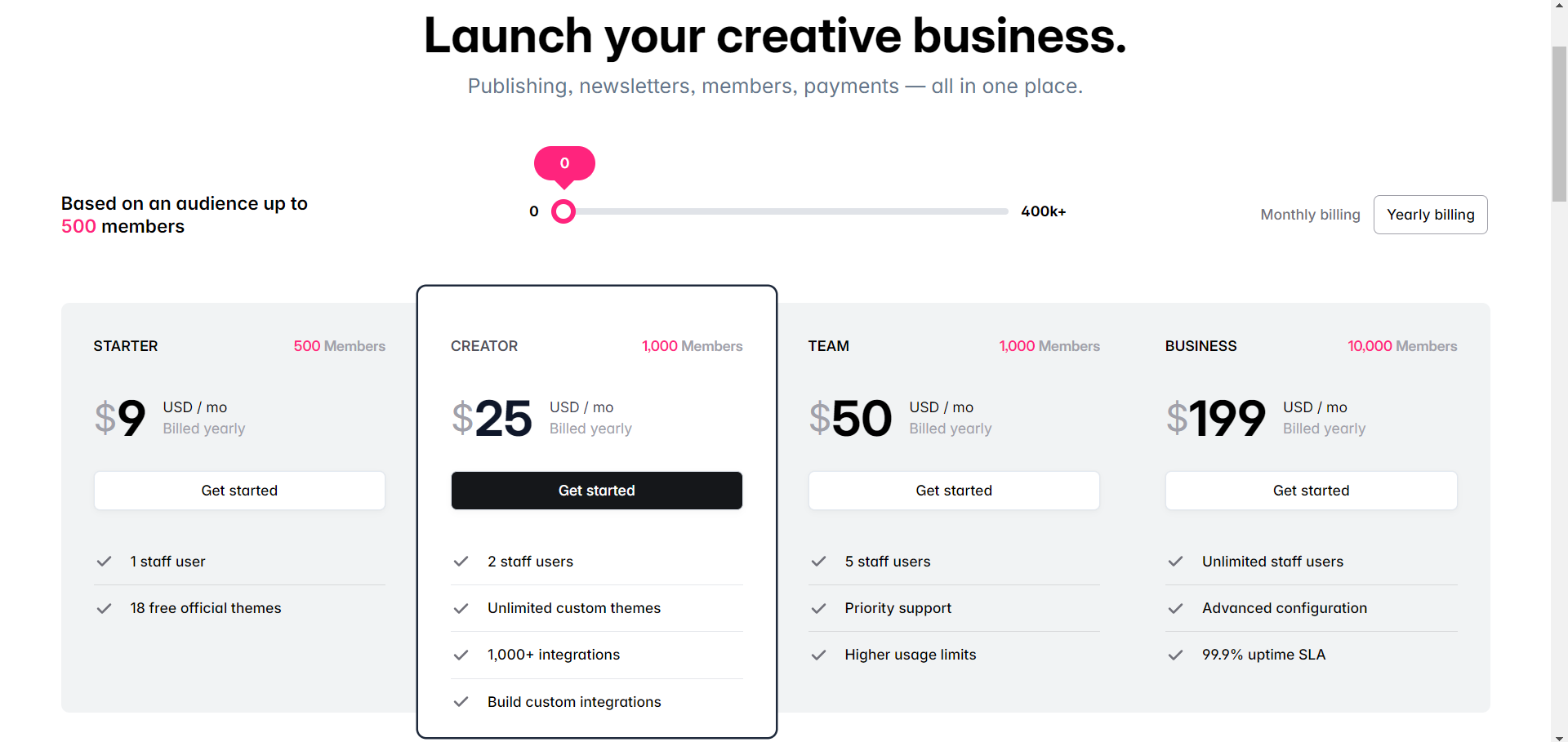
Customer reviews
Ghost received most 4’s and 5’s in review forums. Customers like the clean, easy-to-use UI. They also like the option to view scheduled, published, and drafted articles that work well across mobile and web browsers. Some reviewers mention that editing templates might be a challenge if you don’t have coding experience.
Here’s what Jamie W. has to say about using Ghost:
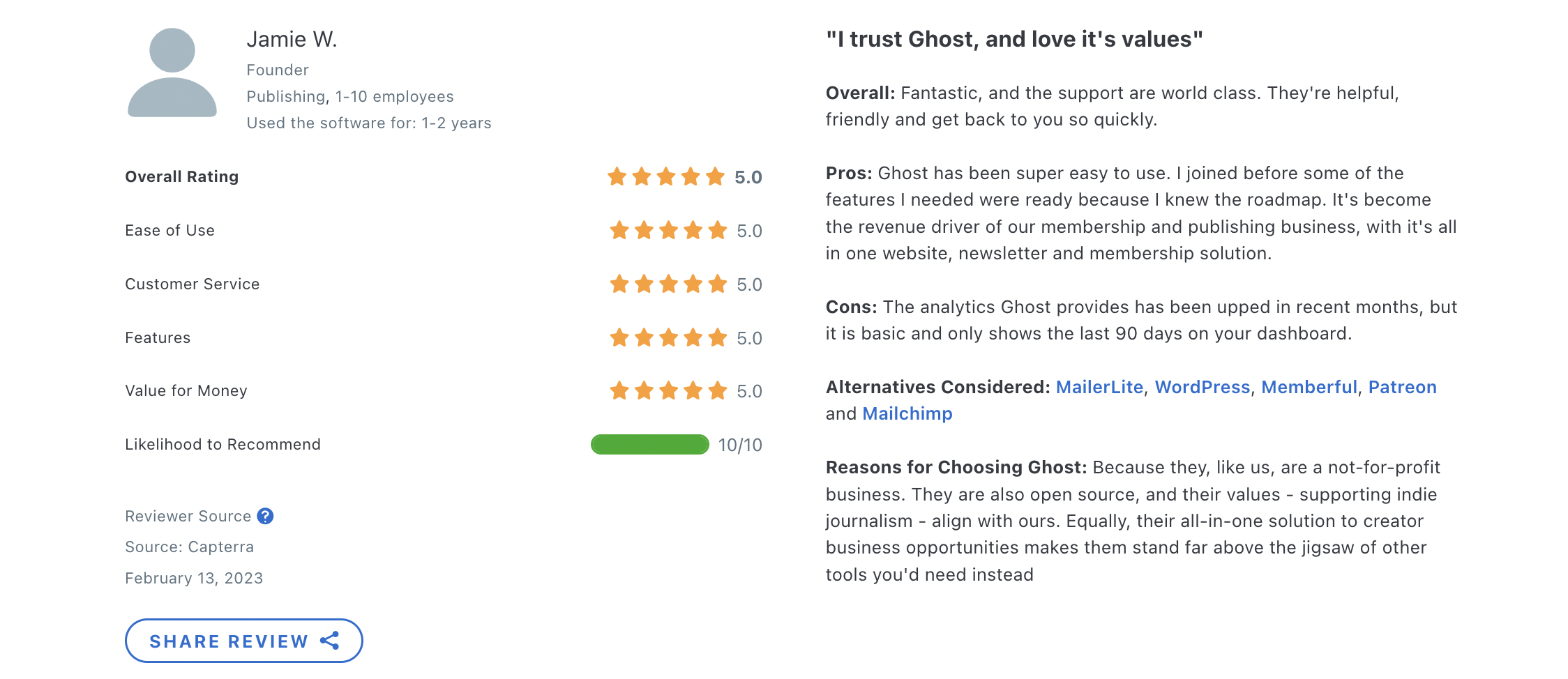
Best for Selling Digital Products: Kit
Kit is a good choice for creators who need to sell digital products.
It gives you the tools you need to design and send emails, grow your audience with its Creator Network, and sell digital products (powered by Stripe).
This is especially useful for businesses that sell courses or paid subscriptions for their newsletter.
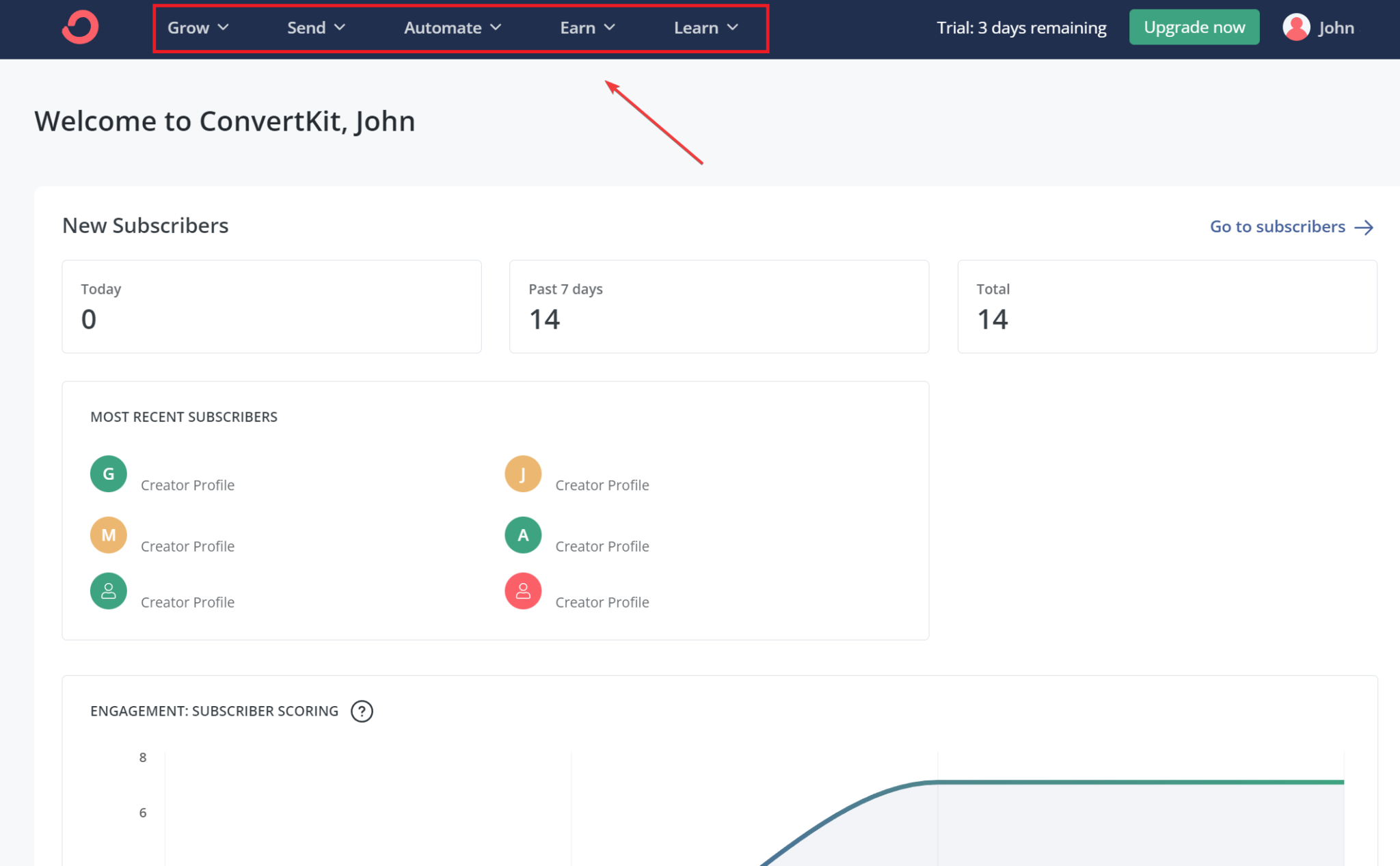
Kit offers a generous newsletter plan that’s free for up to 10,000 subscribers, which is the highest-volume free plan on this list.
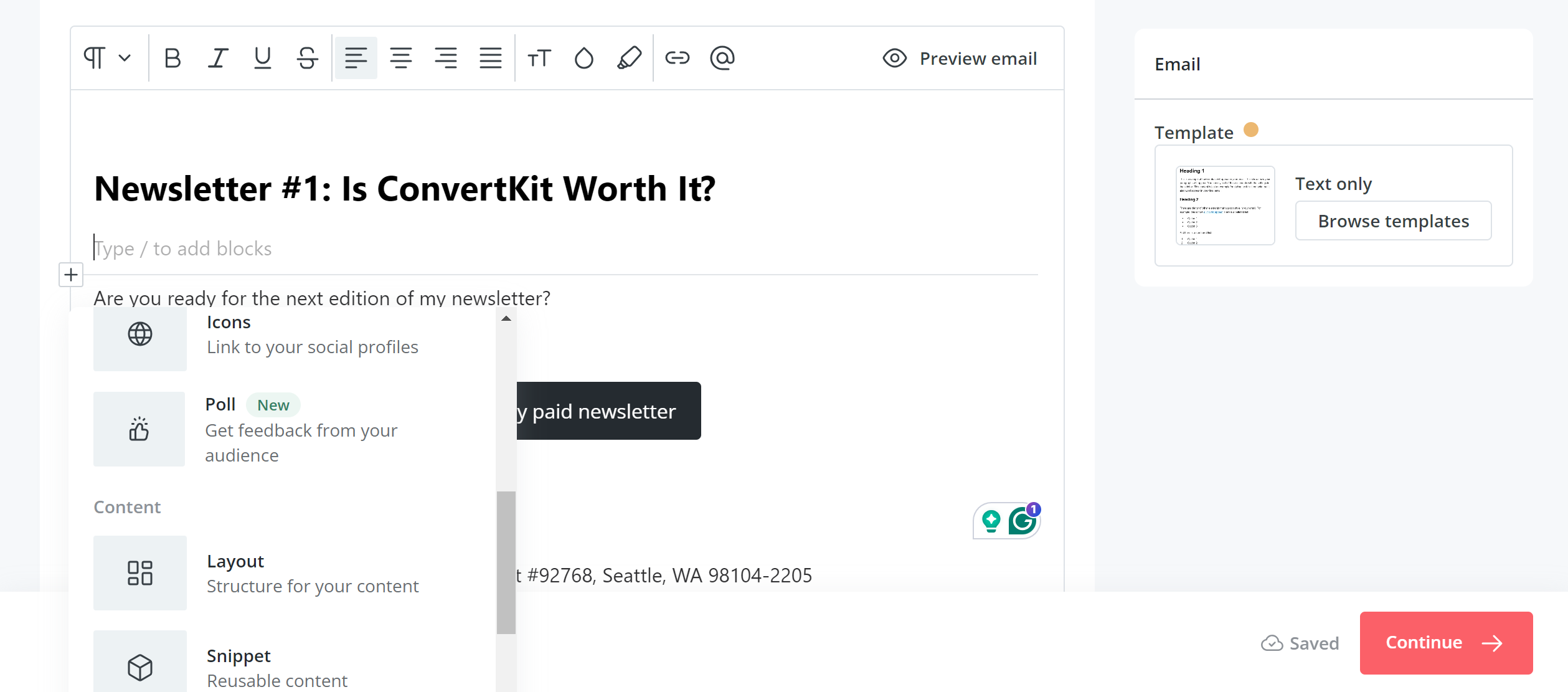
I found the email builder’s UI very intuitive and to have plenty of element options, including polls.
Pros
- Clean, organized UI
- Pre-built email automation templates (which is unique)
- Perfect for selling digital products directly to your audience
- Built-in editor is fast and easy to use
- The Creator Network gives you another option to grow your subscribers
- Offers a free newsletter plan for up to 10,000 subscribers
Cons
- Pricing becomes drastically more expensive than beehiiv’s after 25,000 subscribers
- Email designer can be frustrating to learn (no drag and drop feature)
- Advanced email personalization requires basic coding knowledge
- Landing page builder lacks functionality
- No spam testing
- Doesn’t offer transactional email
- Subscriber referrals are only available on Kit’s more expensive Pro plan.
Features
- Email designer – Visually design email templates or start from customizable pre-built templates.
- Deliverability – Kit boasts an average 99.73% deliverability rate.
- Visual automations – Use a visual building tool to create automated sequences.
- Recommendations – Use the Creator Network to have your newsletter recommended by other popular newsletters with similar audiences.
- Landing pages – Build hosted landing pages with templates and without code.
- Forms – Create signup forms for lead magnets, use pop-up forms, and create categorized signup forms.
- Commerce – Sell digital products and paid subscriptions with Stripe.
- Sponsor Network – Find advertisers through their Sponsor Network for your newsletter.
- Integrations – Integrate with e-commerce tools to make digital sales easy.
- RSS-to-email – Automatically send emails from curated RSS feeds.
Pricing
Kit offers 3 main plans. The free newsletter plan goes up to 10,000 subscribers. The paid plans start at $15/month for 300 subscribers and go up to $2,599/month for 400,000 subscribers.
Here’s how Kit’s paid plans stack up against beehiiv’s:
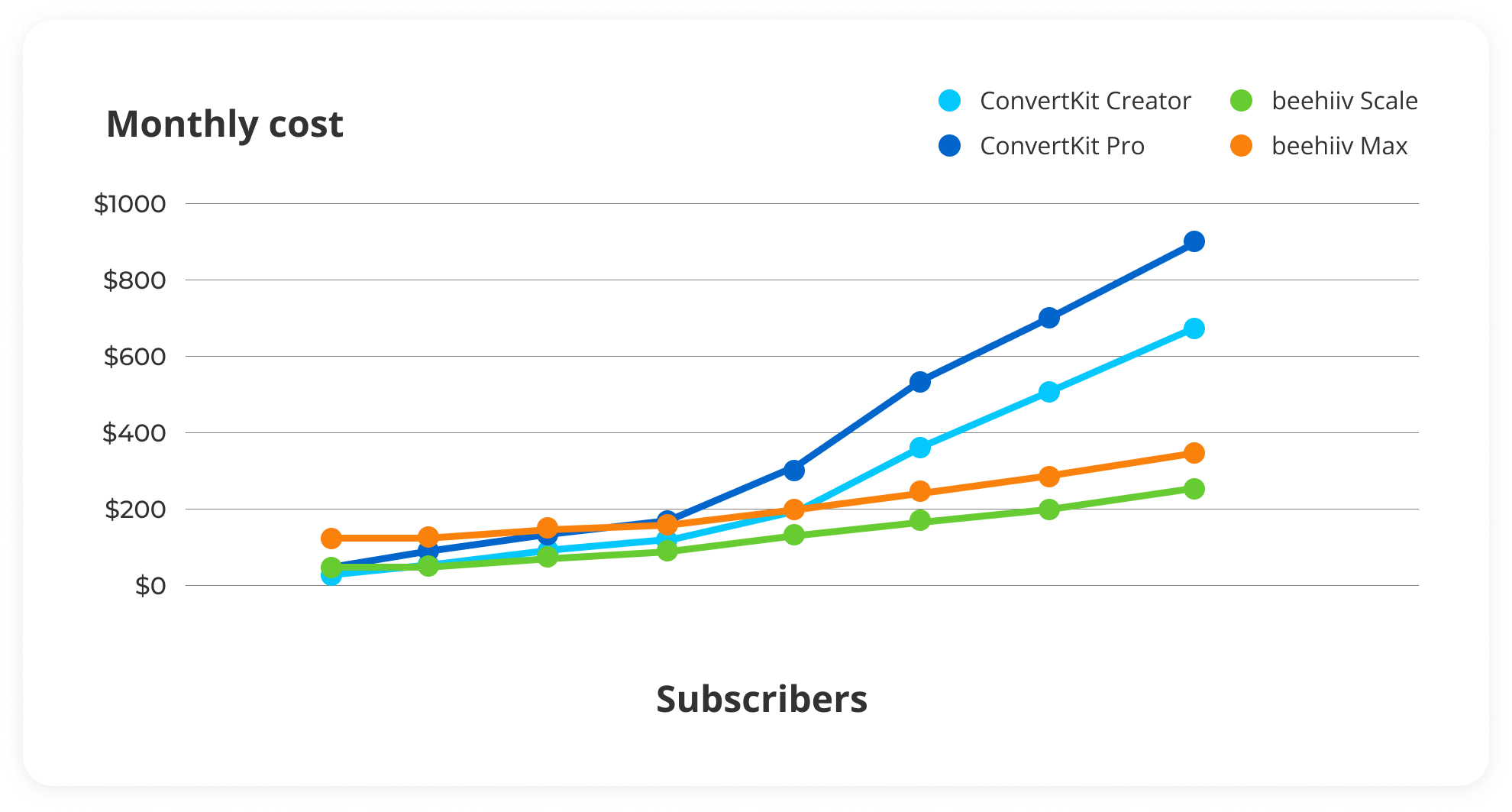
They offer 2 months off when you pay annually.
For more accurate information, check out ConverKit’s pricing page.
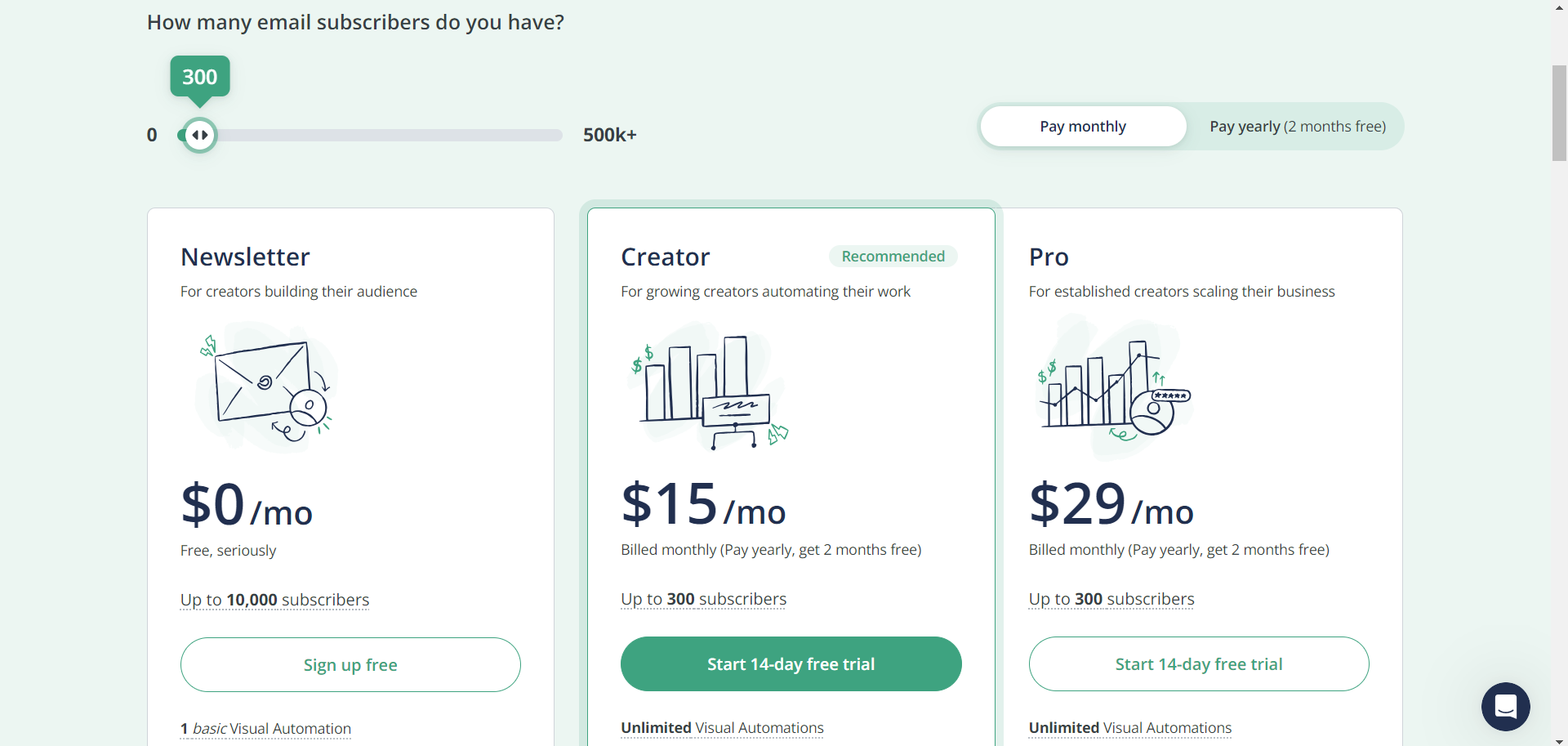
Customer reviews
Kit receives mostly 4 and 5 stars across the board. Users love the easy writing experience and advanced automation features. They also note the Creator Network program has helped build their email list with highly relevant leads by teaming up with other creators with the same audience. There aren’t many common complaints from reviewers, but some wish it had more advanced reporting features.
Here’s what Laura D. has to say about using Kit:
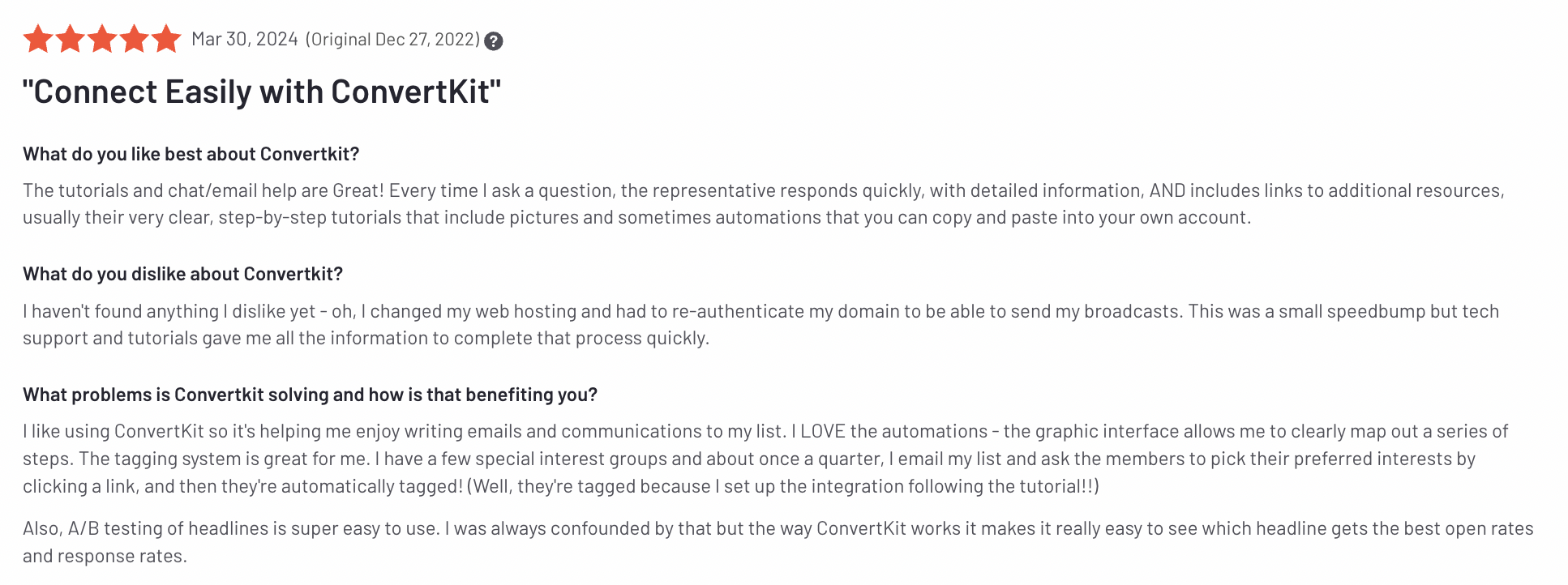
Best for Budget Users: Sendy
Sendy is a self-hosted email newsletter platform (which means the software has to be installed and hosted on your own server).
Emails are sent through Amazon Simple Email Service (SES).
Unlike other platforms, you only pay Amazon SES for what you send after the initial $69 fee for the software, making Sendy the most affordable option on this list.
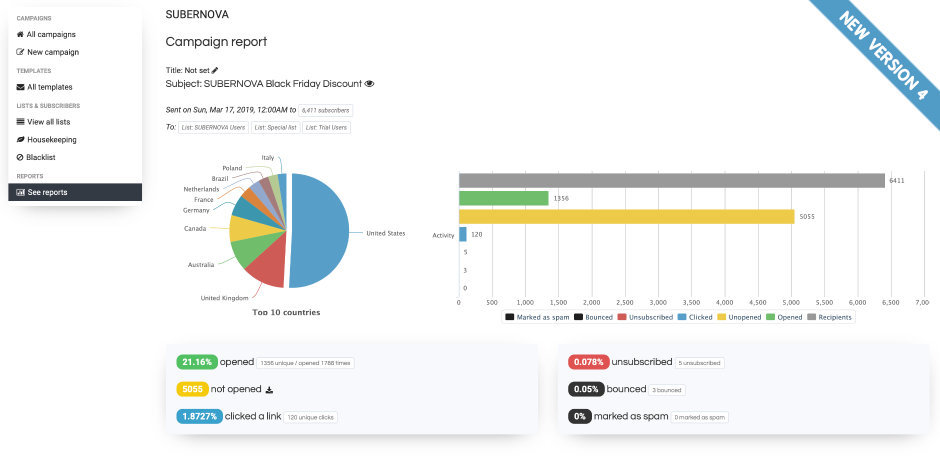
This is the only email service provider on this list that doesn’t have an easy-to-use email template builder or support image hosting.
If you’re technically inclined, the cost savings you get with Sendy might be worth it. However, if you care more about having more built-in features that are easy to use, this won’t be the choice for you.
Pros
- The most affordable beehiiv alternative on this list
- Good functionality for the price
Cons
- Steep learning curve to begin using
- No drag-and-drop email builder
- Requires some technical knowledge
- Basic reporting
- No image hosting
- Customer support is minimal and only available through email
- Some users report that uploading files is slow
- Email sending speed is limited based on your server capacity so an email campaign can take hours instead of minutes to go out on a small, cheap server
Features
- No monthly fees – Pay only when you send emails (emails sent via Amazon SES)
- Reports – See reports to track opens, clicks, bounces, complaints, and countries.
- Autoresponders – Set up automated email drip campaigns for set time intervals.
- White-labeled client accounts – Manage and set limitations for multiple brands under your account.
- List segmentation – Create segments for your email list to deliver to a targeted audience.
- Rules & Webhooks – Set up custom automations that trigger when subscribers take an action.
- List & subscriber management – Organize your email list based on custom fields.
- Custom fields – Store additional contact data besides just “name” and “email.”
- Custom domains – Setup custom domains to send from that are still recognizable as you. You pay for this feature separately based on the number of custom domains you want to add.
- Housekeeping – Easily clean your email list of inactive and unconfirmed subscribers.
- Integrations – Use Zapier to connect Sendy to other apps.
Pricing
Sendy offers the most simple pricing on this list. You pay a $69 one-time fee for the software and then $1 per 10,000 emails sent to Amazon SES. There’s an optional $79 installation fee if you’d like Sendy to be set up for you.
For more details, check out Sendy’s pricing here.
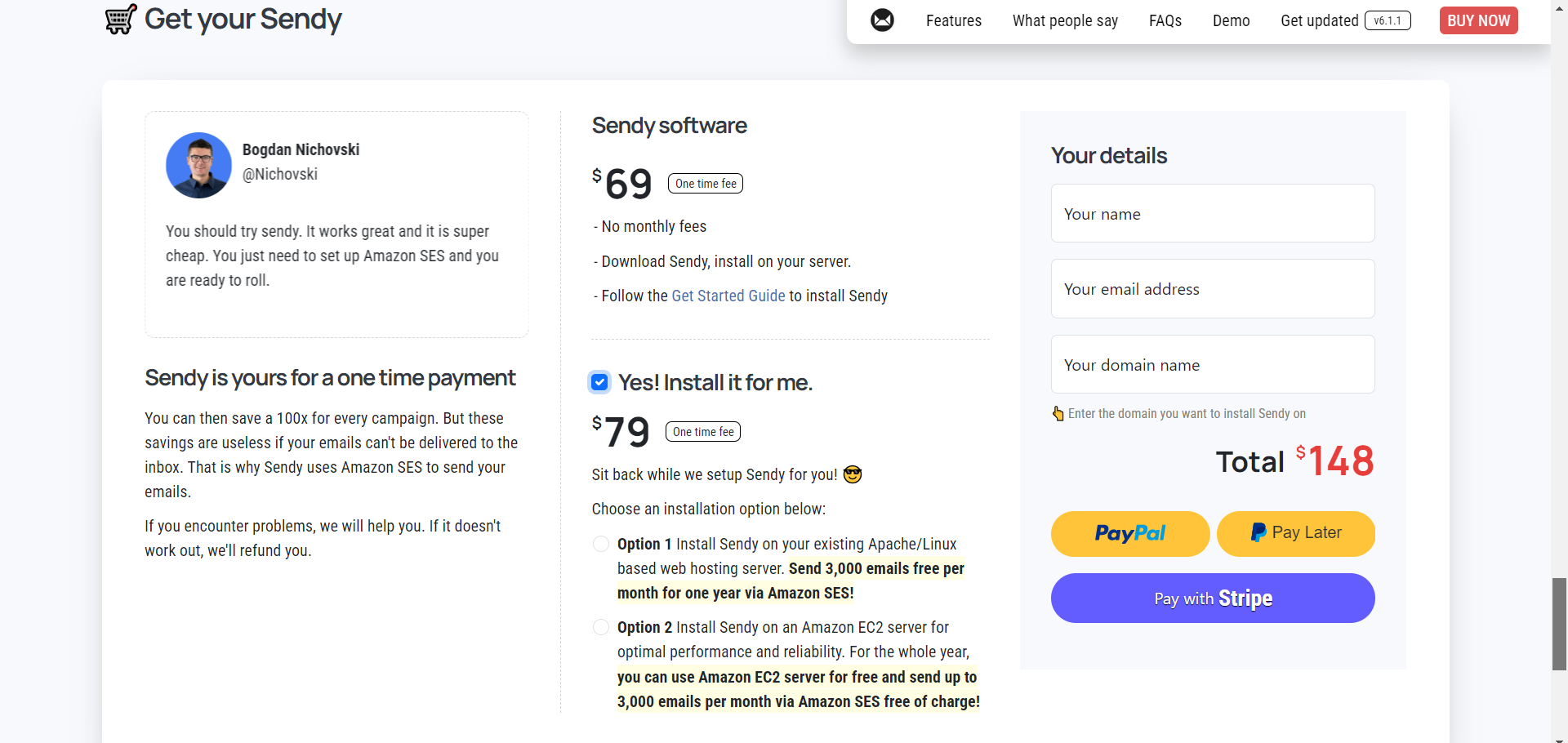
Customer reviews
Similar to other platforms, Sendy received 4 and 5 stars in customer satisfaction surveys. Users commonly praise the platform’s affordability and reliability. However, they also mention the out-of-the-box features are limiting.
Here’s what Charlotte K. has to say about using Sendy:
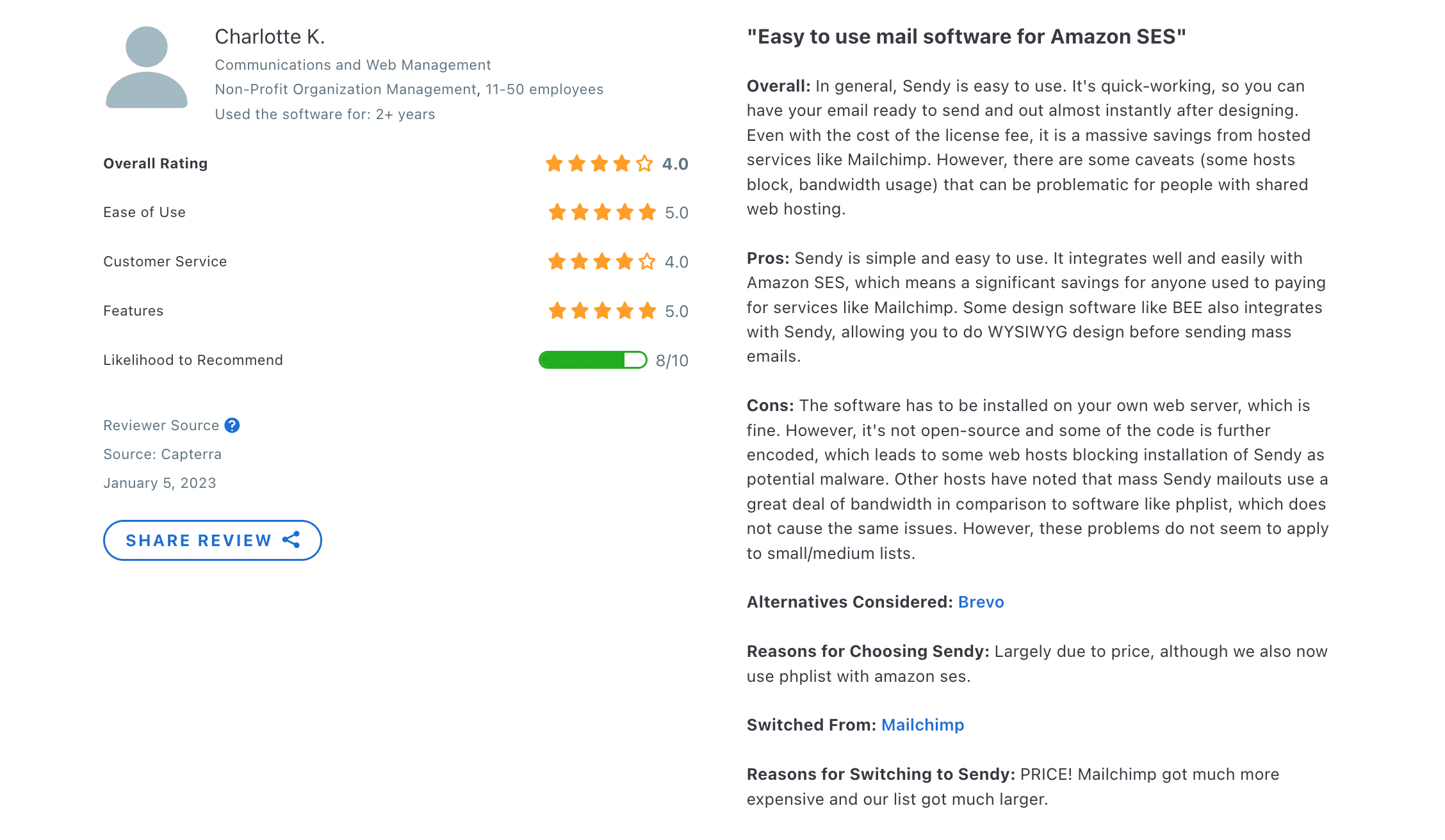
Best for Easy Design: MailerLite
MailerLite is an email marketing service that’s easy to use, especially when it comes to designing emails.
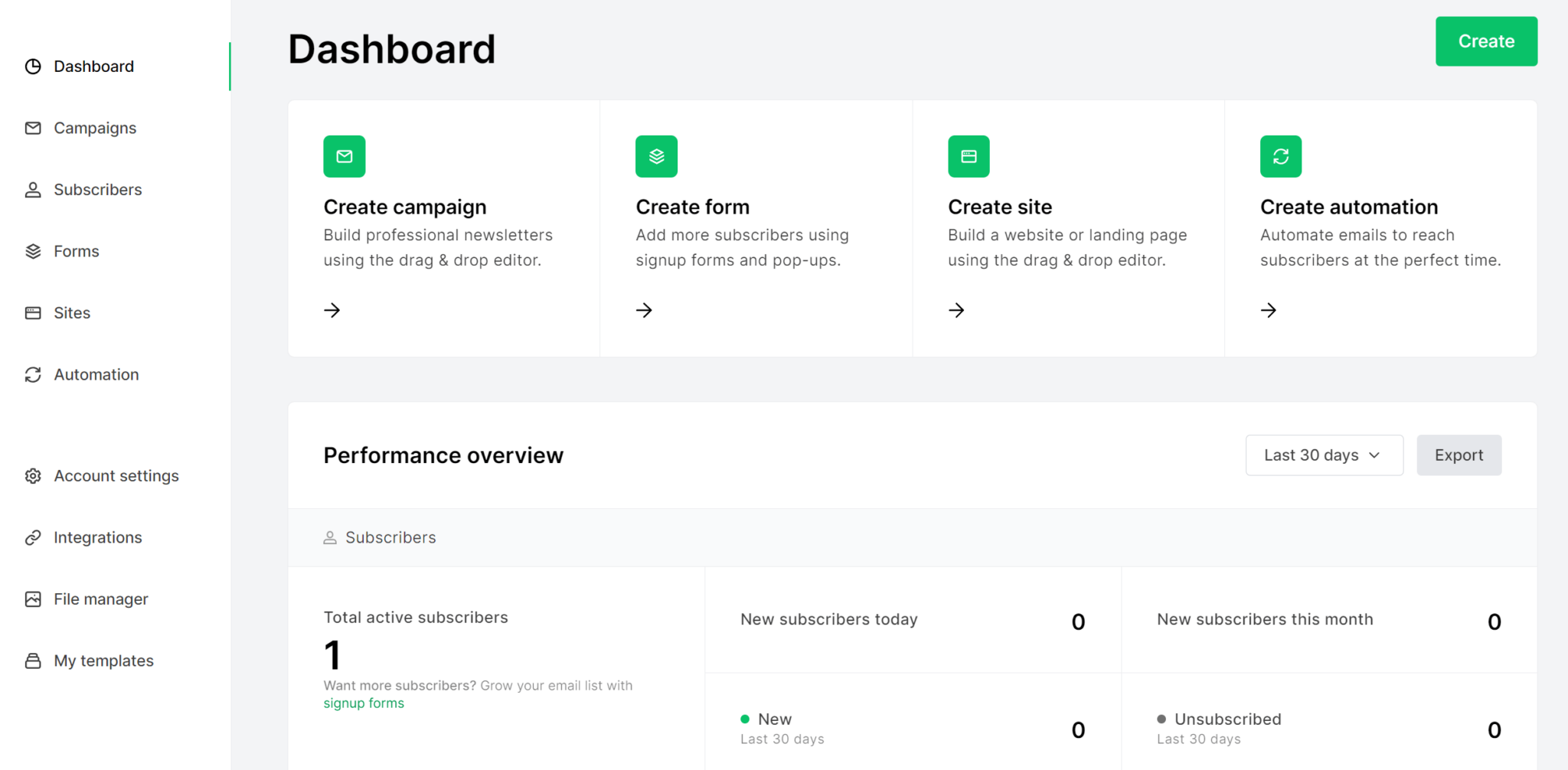
MailerLite is one of the more affordable alternatives on this list, but it’ll still outpace beehiiv in price after you surpass 25,000 subscribers.
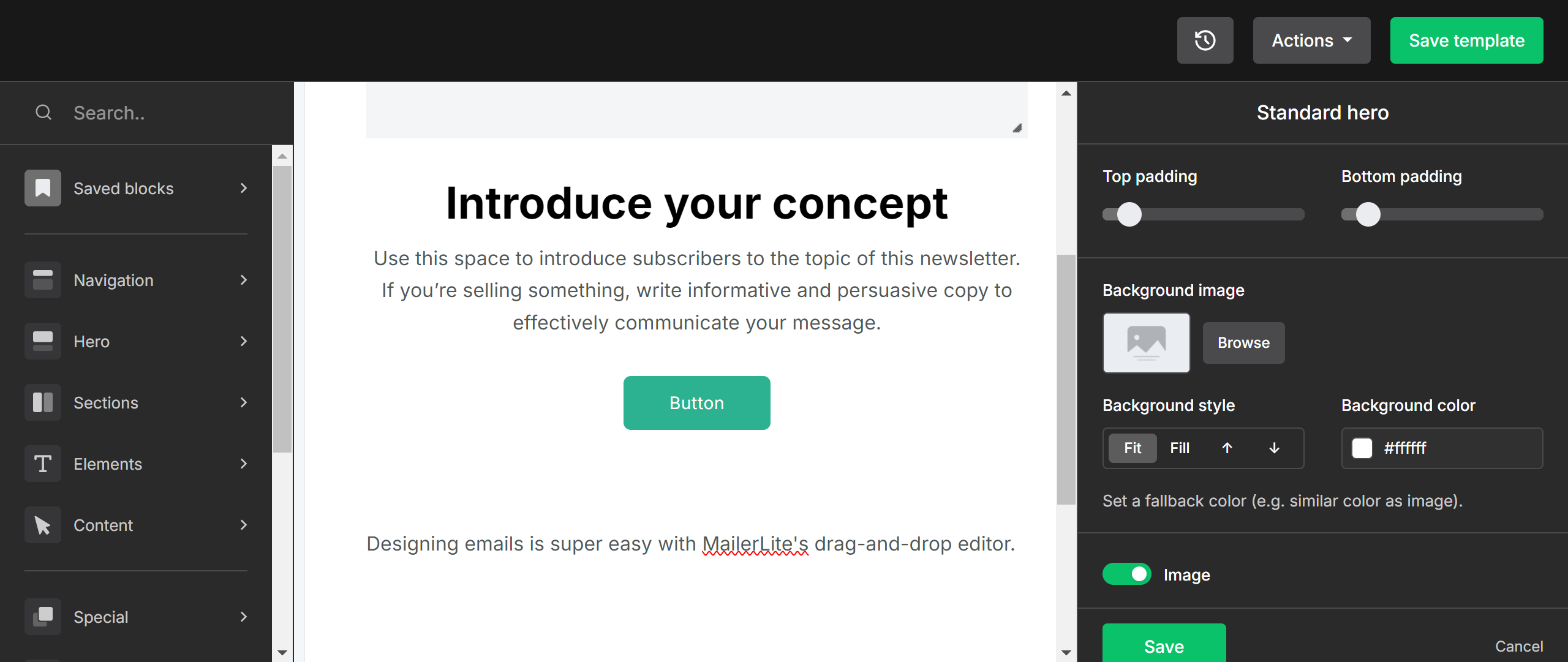
I like how its email designer “blocks” are categorized, making it quick to find design elements to add.
If you’re looking for a newsletter platform that’s also made for ecommerce while still being on a budget, this could be a good choice for you.
Pros
- Free plan for up to 1,000 subscribers
- Loaded with features (including for building a website)
- Easy to use drag-and-drop email template builder
- More affordable than beehiiv if you have fewer than 10,000 subscribers
Cons
- Live chat support is only available on the more expensive Advanced plan
- Custom HTML templates are only available on the more expensive Advanced plan
- Becomes more expensive than beehiiv when you have over 50,000 subscribers
- Reviewers commonly mention various bugs
Features
- Automation – Set up automated workflows and sequences based on triggers.
- Newsletter editors – Design your newsletters with a rich text or drag-and-drop editor.
- Email notifications – Send notification emails to your customers.
- Website & blog builder – Build a website with blog capabilities using a drag-and-drop editor.
- Landing pages – Create customizable landing pages with a drag-and-drop editor or start by generating one with AI.
- Signup forms – Capture signups with embedded and pop-up forms.
- Email verifier – Use MailerCheck to verify email addresses in bulk.
- Digital products – Sell your digital products with Stripe, then deliver them with email.
- E-commerce – Connect your ecommerce platform to send transactional emails.
- Paid newsletter subscriptions – Offer paid subscriptions with their Stripe integration.
Pricing
MailerLite offers 3 main plans for marketing emails. The free plan goes up to 1,000 subscribers. Paid plans start at $10/month for up to 500 subscribers and go up to $1,520 for 400,000 subscribers.
Here’s how MailerLite’s plans compare to beehiiv’s:

If you sign up for an annual plan, you can get 10% off.
Check out MailerLite’s pricing page for more accurate details.
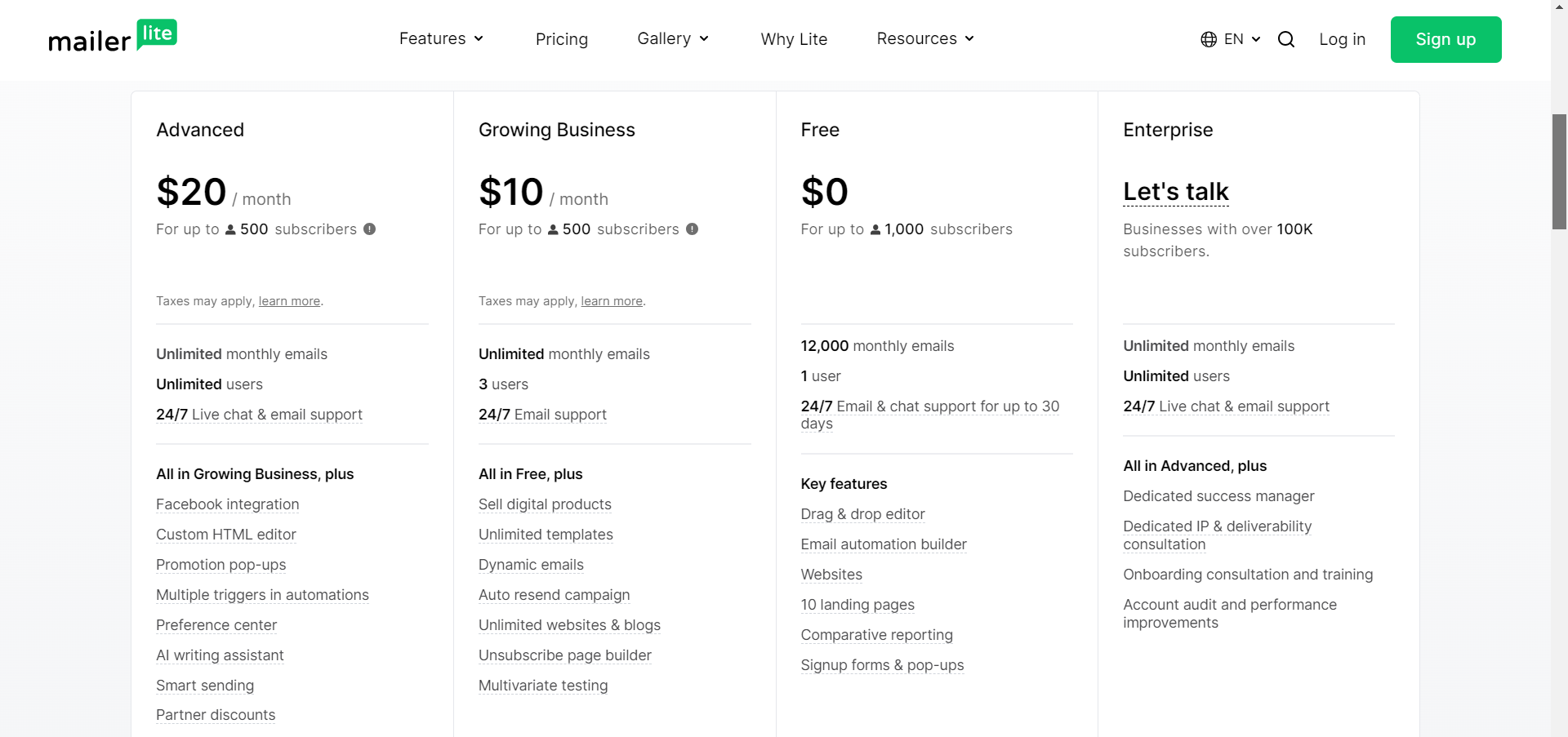
Customer reviews
Mailerlite receives mostly 4 and 5-star reviews from its users. Most reviews praised the affordable pricing. It seemed like reviews were mainly very positive or negative when it came to the support.
Here’s what one verified user has to say about using MailerLite:
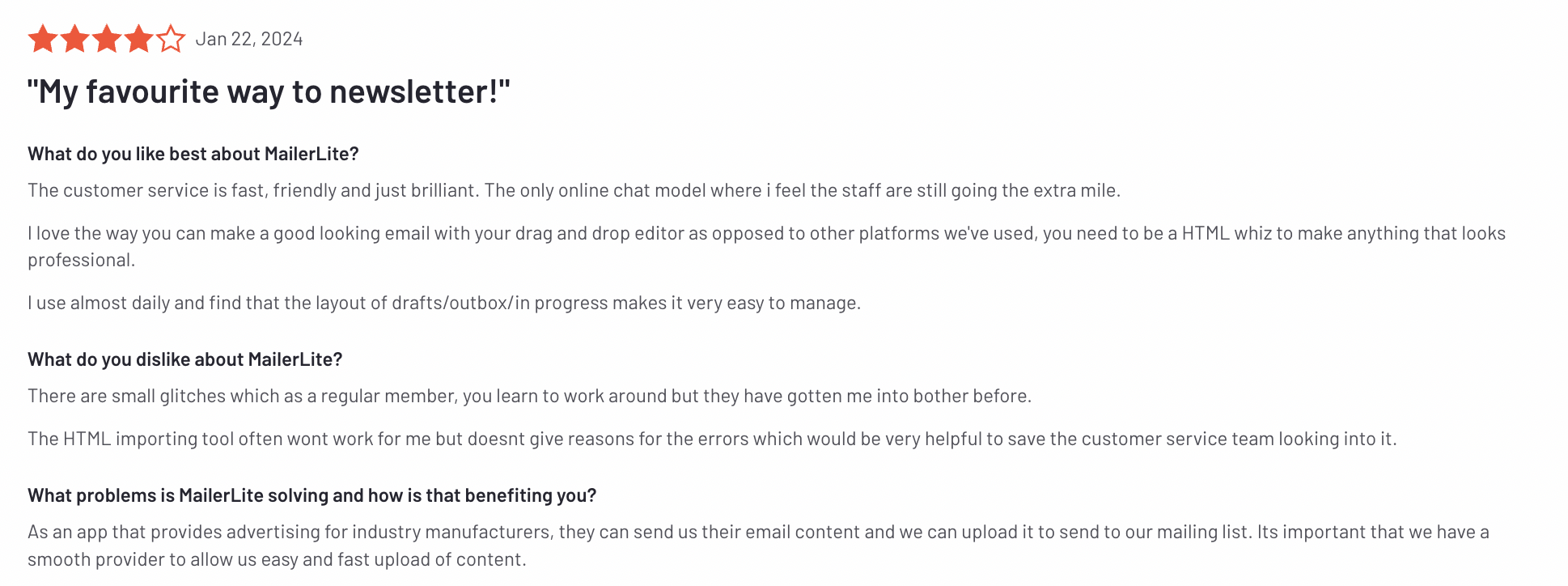
Beehiiv alternative evaluation checklist
So which beehiiv alternative will best fit your needs?
Here’s a checklist to help make your decision easier:
- Does it fit your budget?
- Is it easy to use?
- Who will be primarily responsible for working with the email platform? Are they tech-savvy?
- Does it have the features you need?
- Which features and capabilities are the most important to you and your clients?
- Does the platform help you follow email deliverability best practices by helping you filter out bad emails?
- Does the platform meet your compliance standards?
- Does it integrate with the software you already use?
- Will it grow with your email list without drastically increasing costs?
- Is the customer support reputable and known for being available & helpful?
Ready to make the switch from beehiiv?
If you’re a marketing agency, email consultant, or have a large team, BigMailer has all of the features you need to create, distribute, and grow your newsletter — at a much lower cost than beehiiv.
Have questions about BigMailer’s features or pricing? Reach out to us via chat or schedule a demo.
Or, if you’re ready to give the BigMailer platform a try, get started with a free account.
Author: Jacob Statler
